Having visited the Monastery of St. Nicholas, I went back to the main road and continued in the direction of Ovčar Banja. Along the way, there are a few more smaller tunnels and the sights were interesting, especially at the time when the Sun was setting.
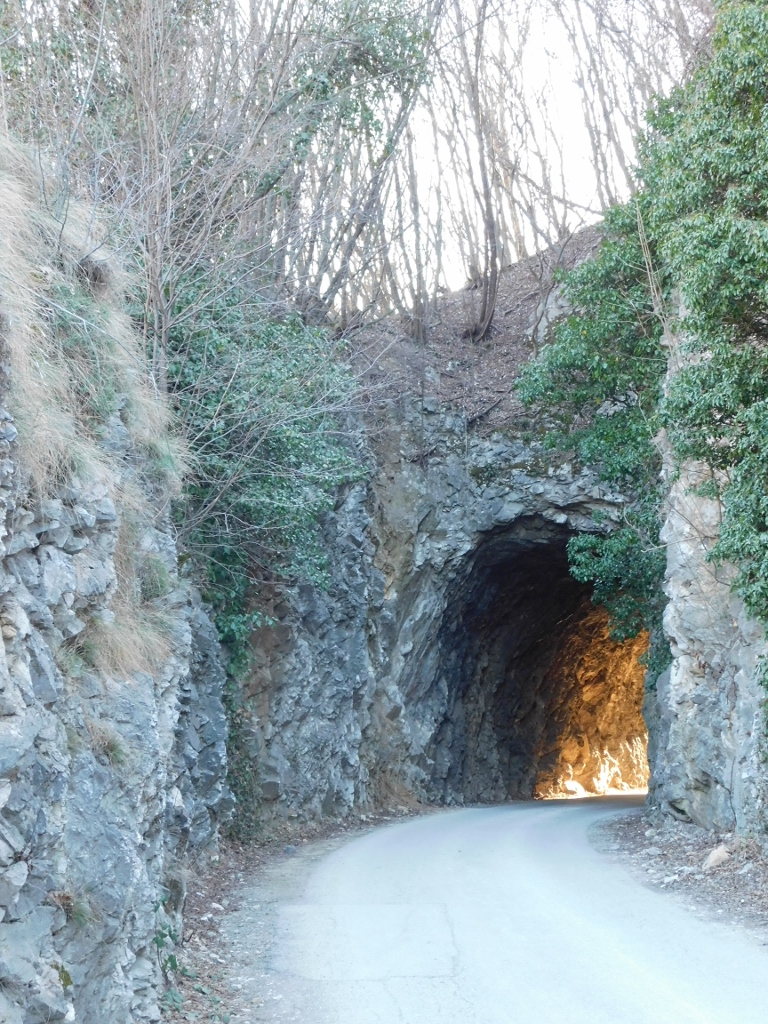 Tunnel on the road to Ovčar Banja
Tunnel on the road to Ovčar Banja
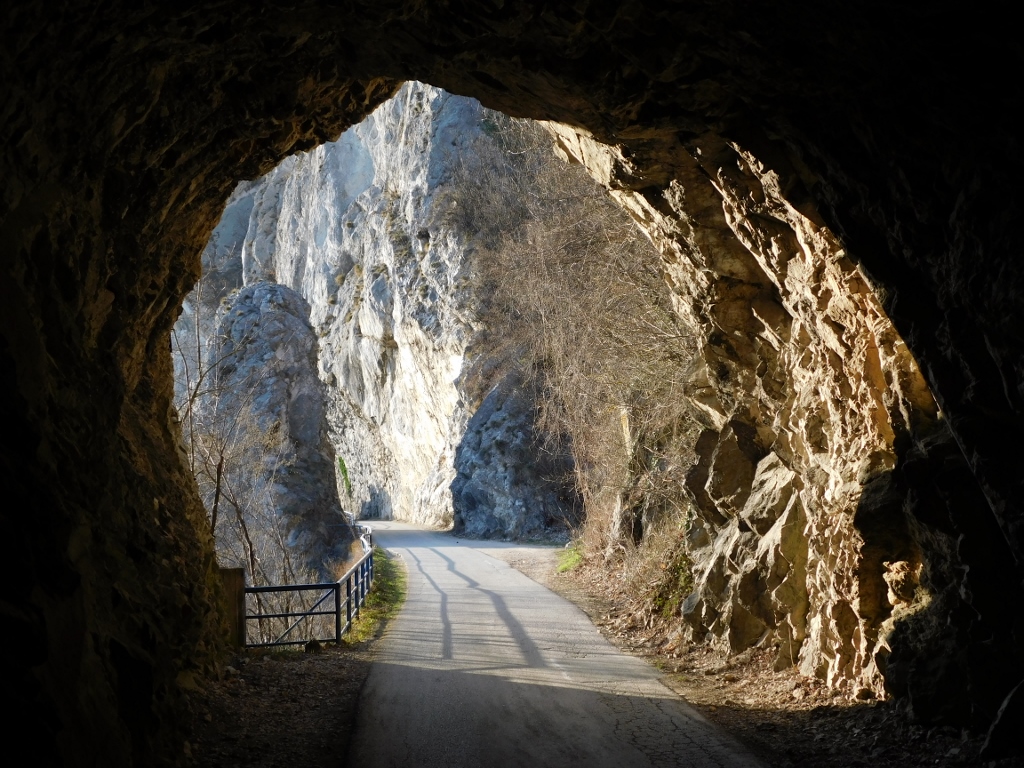 Tunnel on the road to Ovčar Banja
Tunnel on the road to Ovčar Banja
I have already mentioned earlier that the south side of mount Kablar consists of numerous high rocks and cliffs, so it is very usual here to see alpine climbers practicing and climbing the often quite vertical cliffs.
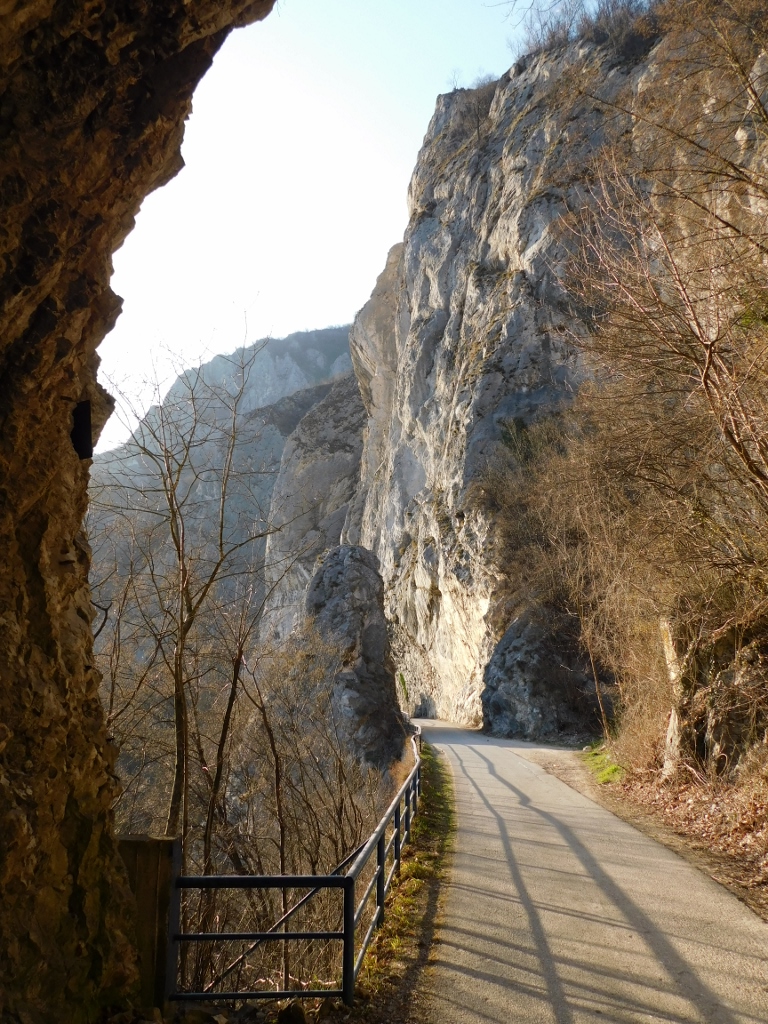 South parts of Kablar
South parts of Kablar
Then I got to the area from which I had started towards the Hermitage of St. Sava earlier in the day. On the other side there is a suspension bridge across the Zapadna Morava river. When I used to come here with my hiking club, we would always use this bridge to cross the river and go for a hike on mount Ovčar.
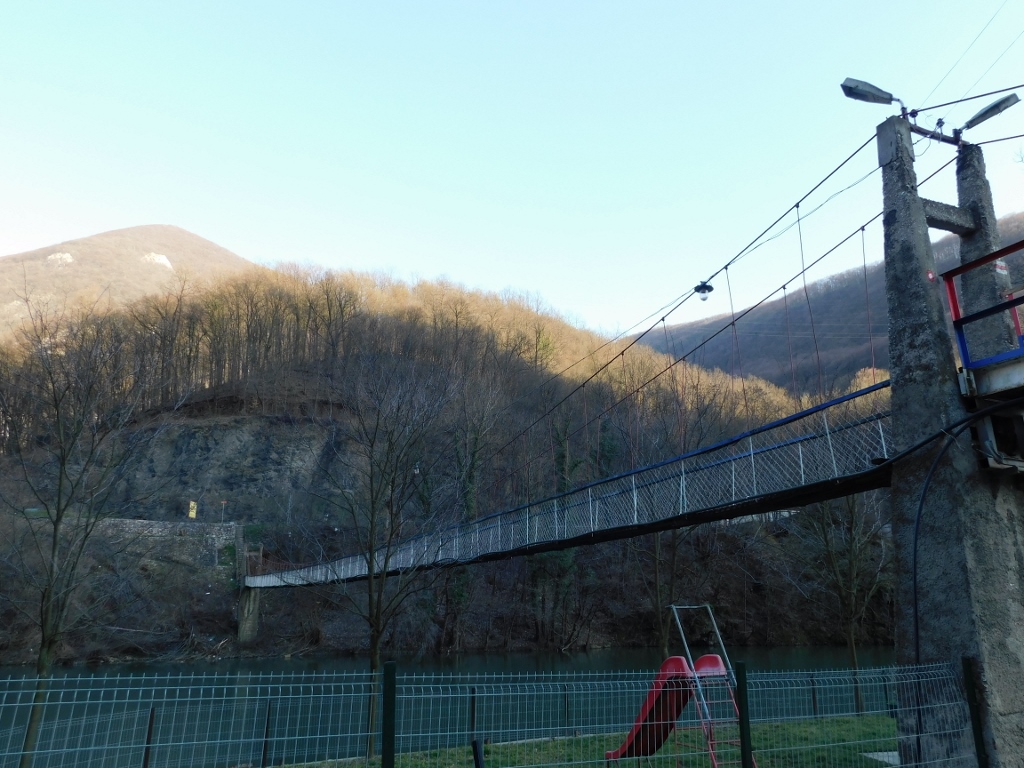 Suspension bridge in Ovčar Banja (top of mount Ovčar may be seen on the left)
Suspension bridge in Ovčar Banja (top of mount Ovčar may be seen on the left)
Bearing in mind, however, my current state, I was not sure at all that the following day I would go anywhere. I was very tired and I could barely drag myself towards the hotel. The only comfort was that right after the arrival the previous day, I had made an appointment for a massage this evening. I was only not sure that I would stay awake until 8.30 pm when the massage was to start.
Be as it may, I did get to the hotel, took a shower, got down to the restaurant for dinner and then I organised everything well, so that right after the massage, I just went to my room, got into the bed and turned off the light. I fell asleep right that second.
After that massage and the unusually long and deep sleep, the following morning I woke up relatively normally. I felt a little rusty, but not dramatically so. I was still not sure how I would organise this day. I decided to start with my planned actions, see how that was going and then I would adjust. Here is the map again with all the places that I visited during this trip marked:
To start with, I wanted to go by car to the Monastery of the Ascension of our Lord (Vaznesenje). The monastery was practically on my way when I came from Čačak, but at that time I did not see any sign marking the turn. Since I planned to return to Čačak following a different road, then this was my best chance to visit the place. The Monastery of the Ascension of our Lord is a little over 4 km away from Ovčar Banja.
Later I found out that in fact visitors do not turn towards the monastery when driving from the direction of Čačak, since the angle is very sharp, while the road to the monastery is narrow and steep so this would not be easy and is certainly not safe either. This is the reason why there is no sign showing where to turn. What the visitors actually do is to pass the turning point, drive on for another hundred metres or so and stop at a parking lot that exists there. Then, when it’s safe, they make a U-turn and approach the road to the monastery from the direction of Požega.
Now I was coming from the direction of Požega anyway, i.e., from Ovčar Banja, so I had no problems whatsoever and thus I reached the spacious parking lot in front of the monastery a little after 8 am. The massive gate was locked.
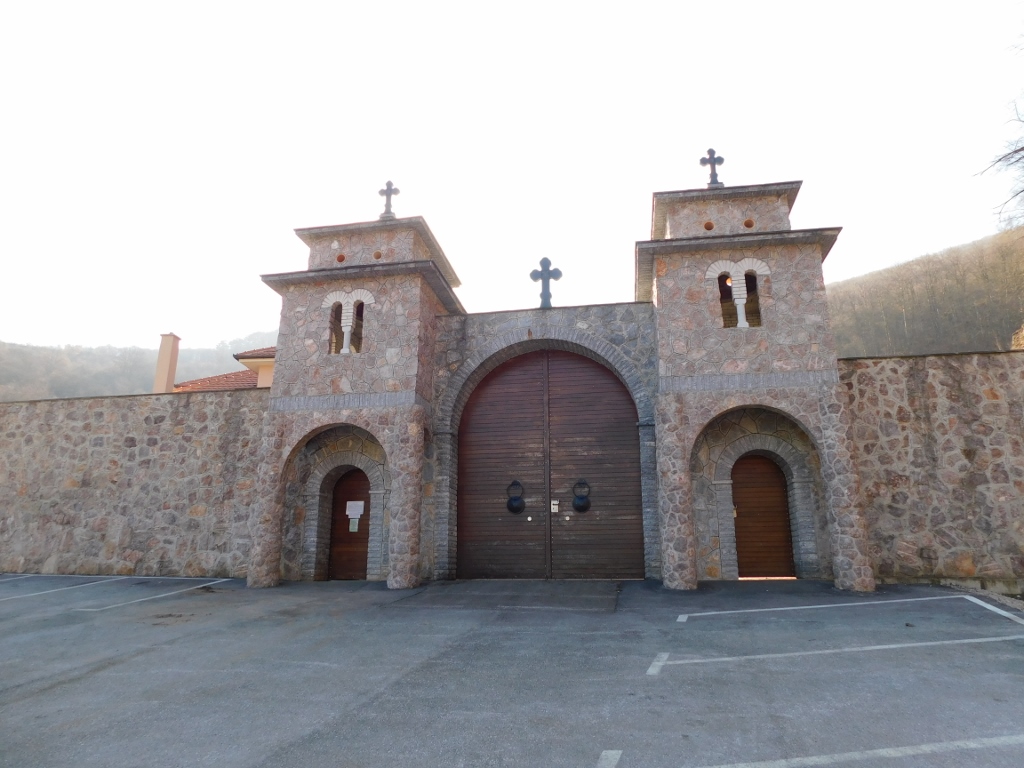 Monastery of the Ascension of our Lord
Monastery of the Ascension of our Lord
There was a notice on the door that the visits to the monastery were from 8 am, but I still could not get in. I even used the door knocker on the main gate, but nothing happened. By the way, it was also written that women had to wear long skirts (below knees) and men long trousers, but I was already prepared for this having put on over my pants the skirt I carried with me for this purpose Since nobody opened the door for me, I went along the road that led to the side and there, a little farther away, there was indeed an open access to the monastery above which rises mount Ovčar.
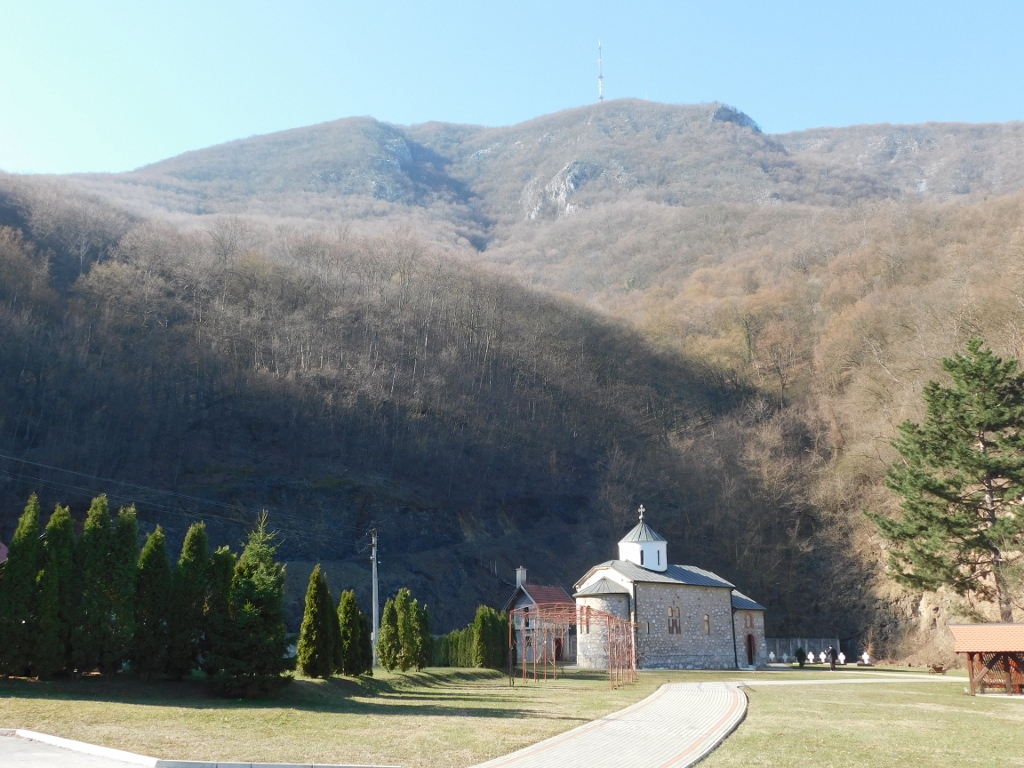 Monastery of the Ascension of our Lord
Monastery of the Ascension of our Lord
It is believed that the monastery was built in the 12th or the 13th century, but it is known for a fact that it was active in the 16th century. Then it was in ruins for a long period of time, most likely devastated by the Ottomans at the end of the 17th century. In 1937, the church was restored by the future Saint Nikolaj of Ohrid and Žiča. Although it was a women’s monastery for a long time, in 2012 it was turned into a men’s monastery.
I came across a monk, so I greeted him and asked if I could visit the church. Of course I could, he said, and went on his way, since there was a handyman working on something within the yard.
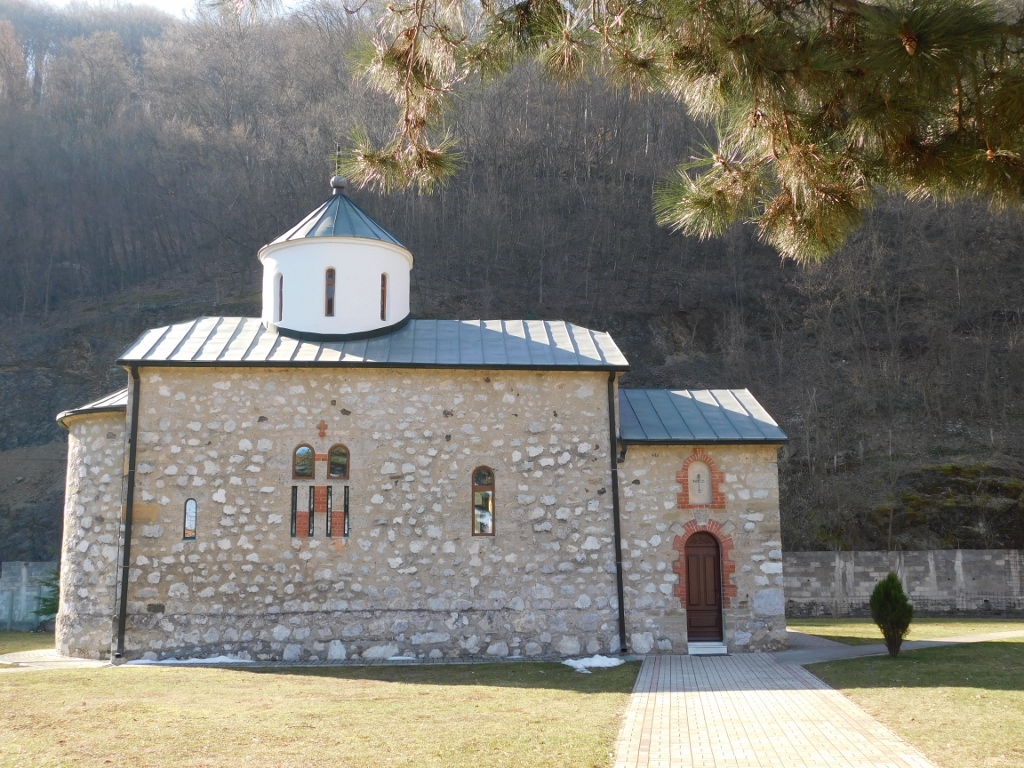 Monastery of the Ascension of our Lord
Monastery of the Ascension of our Lord
I entered the modest narthex, but the door leading to the naos was locked.
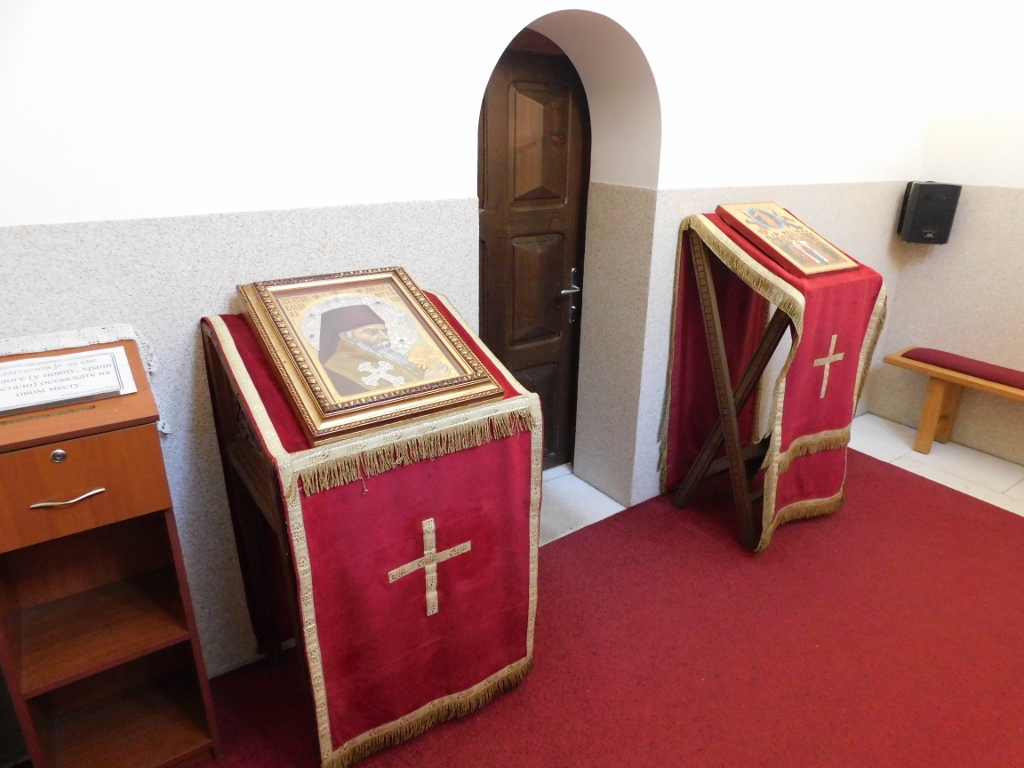 Monastery of the Ascension of our Lord, the narthex
Monastery of the Ascension of our Lord, the narthex
I took the photos I could and then I walked over to the monk who was talking with that handyman. I waited for them to finish and then I asked him if he could unlock the door for me. He said that the church was for liturgy and what may be taken photos of is already open. I asked him if I could at least see the church, without taking photos, but he just reiterated that the church was for liturgy. I realised that obviously each monastery had its own rules, so I thanked him, walked around the yard for a short while and then went back to my car.
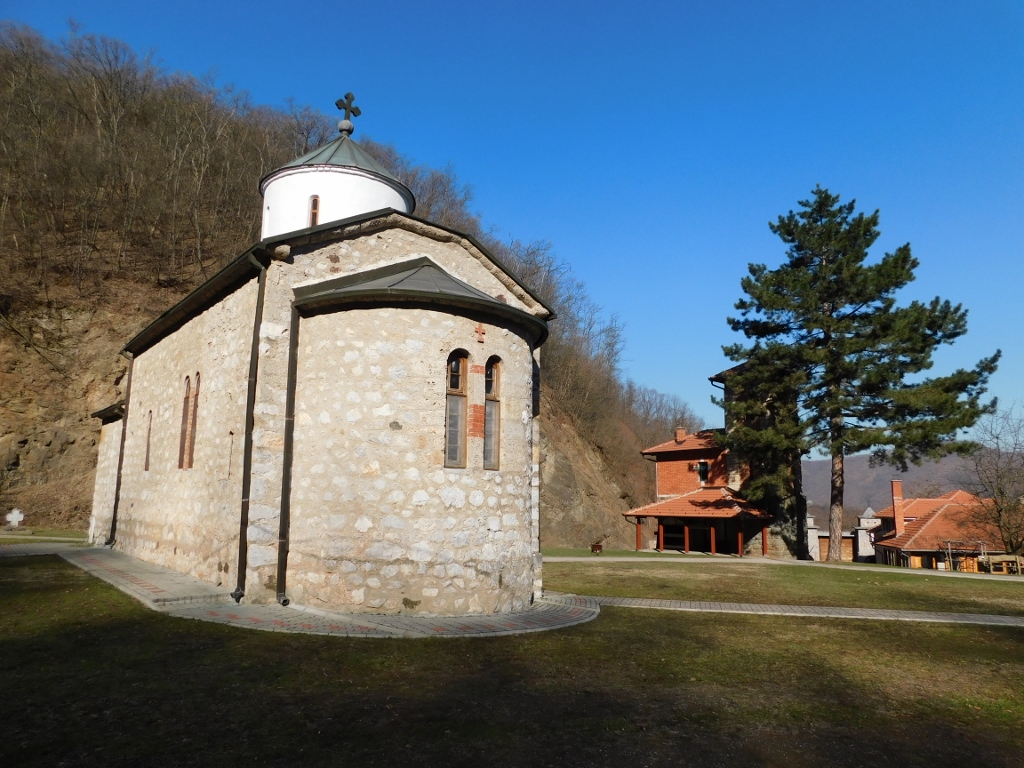 Monastery of the Ascension of our Lord, the yard
Monastery of the Ascension of our Lord, the yard
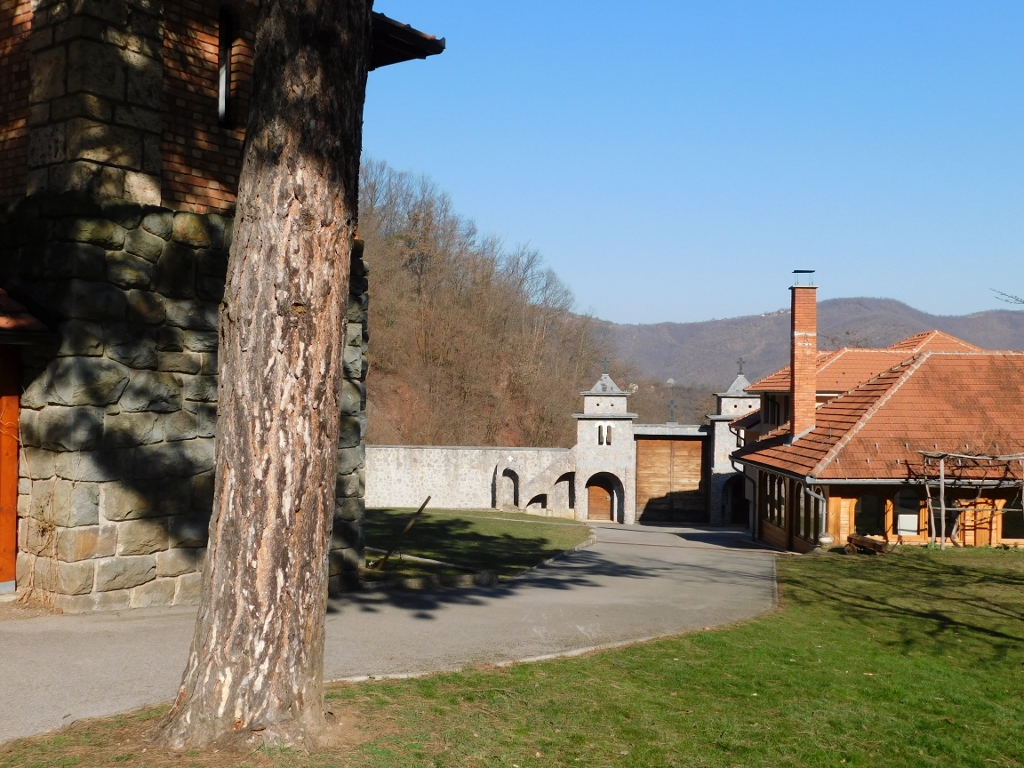 Monastery of the Ascension of our Lord, the yard
Monastery of the Ascension of our Lord, the yard
As I was taking off that skirt I wore over my pants, it seemed I could hear something high up in a treetop. I looked up and could not believe it. There was a beautiful common buzzard (Buteo buteo) there.
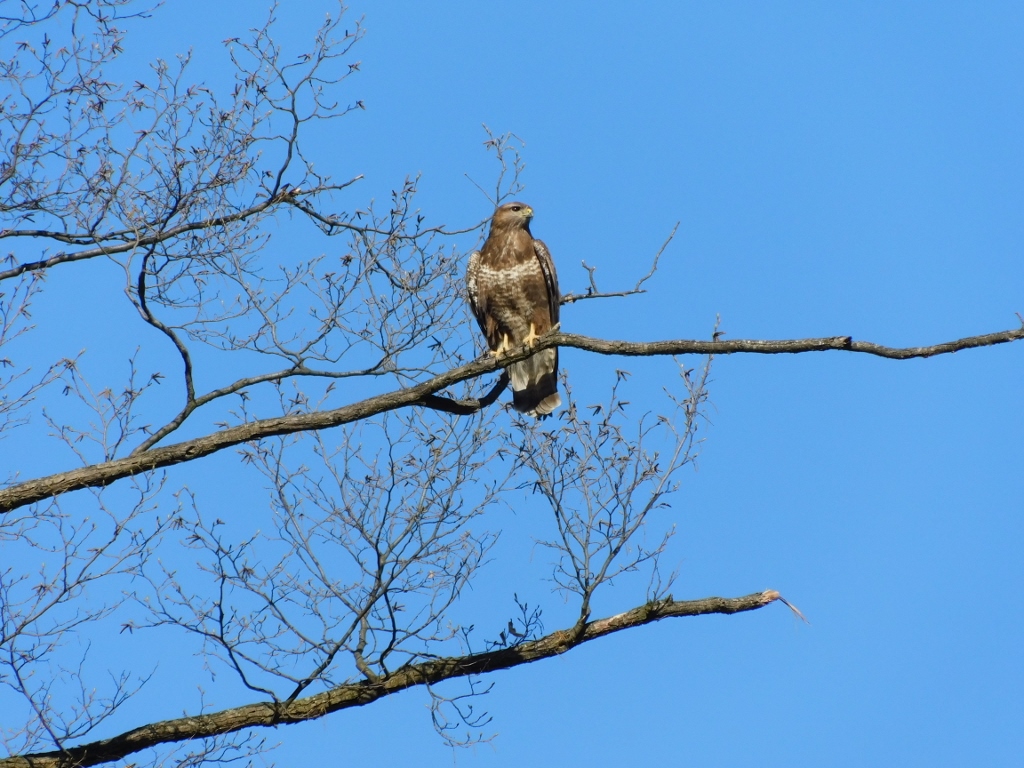 Common buzzard
Common buzzard
Soon I returned to Ovčar Banja and my hotel where I had breakfast. Although my car ran smoothly now and made no problems, I called up a repair shop in Čačak just in case and agreed that I would stop by around noon the following day, before I headed back to Belgrade. In other words, I could be at ease now.
Since my plan for the day was to go to the Monastery of the Meeting of the Lord in the Temple (Sretenje) and the Monastery of the Holy Trinity (Sveta Trojica), and they are both situated on mount Ovčar, I was thinking about whether it would be better for me to go there by car, taking into consideration the exhaustion I had felt the night before, as well as the fact that there is an asphalt road to them (admittedly not from Ovčar Banja, but rather from the completely opposite side). However, since I felt comparatively well and was certainly functional, I decided to go there on foot.
To start with, I headed downstream along the left bank of the Zapadna Morava river. The Zapadna Morava is not a particularly deep river and at this time of the year it was very clean and had a nice colour.
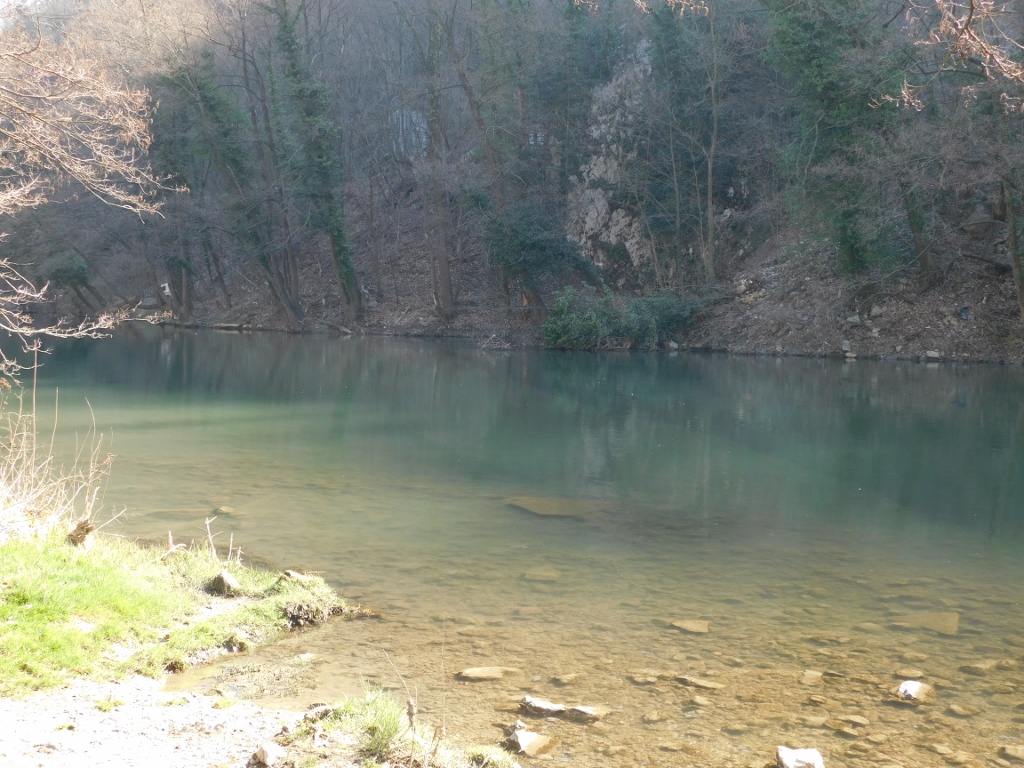 The Zapadna Morava near Ovčar Banja
The Zapadna Morava near Ovčar Banja
I walked towards a restaurant with accommodation “Dom.” This place was originally a railway station in Ovčar Banja (there is a newer one now, a couple of hundred metres closer to the spa). When this new station was built, the Railway Company gave the old building to the hiking club “Železničar” (“Railwayman”) from Belgrade and thus the building was turned into a hiking lodge. Back in the day I used to be a member of this hiking club and so I often came here to Ovčar Banja. I remember that the first time I stayed at the lodge we had to sleep on the floor, but later the building was rented to a businessman from Čačak who turned it into a restaurant, as well as a small hotel, improving his offer over time. The last time I stayed here, there were rooms with shared bathroom on the first floor, but the second floor had rooms with private bathroom.
On this particular day, my plan was to visit the other side of the Zapadna Morava, so I walked over the suspension bridge that exists right close to “Dom.” This bridge was made who knows when. I walked over it many, many times, so like before it swayed (after all, it is a suspension bridge), but I could also see that it would not be a bad thing for the bridge to undergo a thorough overhaul. It is quite OK to walk over it, but some kind of renovation would be in place.
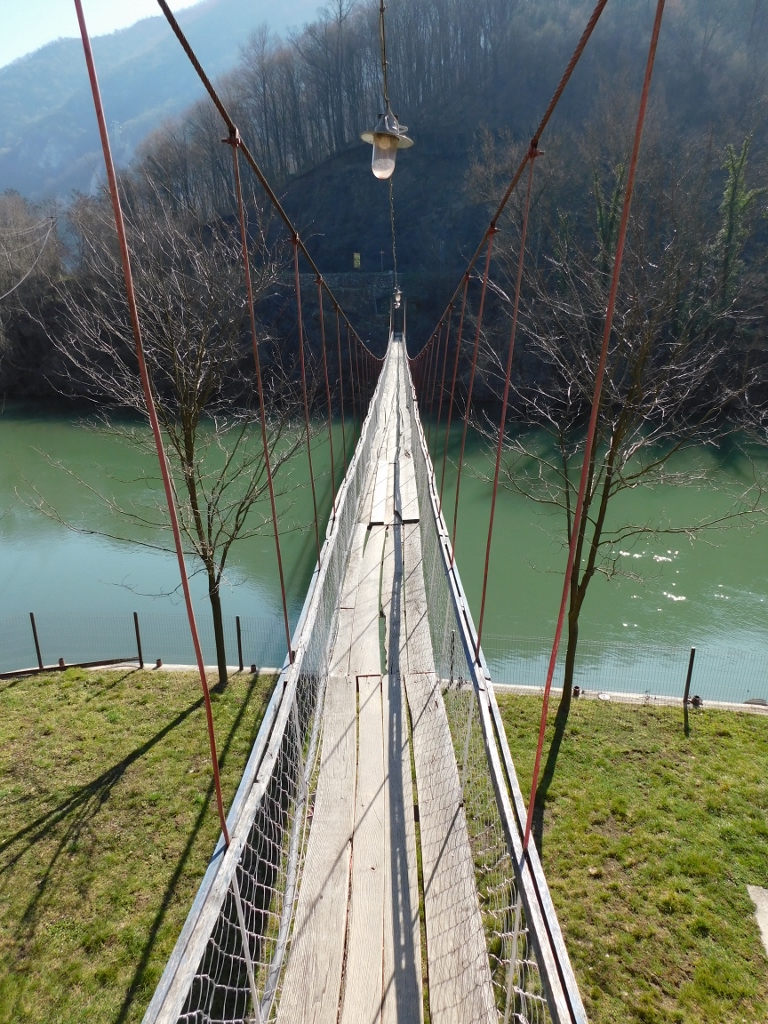 Suspension bridge in Ovčar Banja
Suspension bridge in Ovčar Banja
When I crossed the bridge and climbed up to the level of the road, I turned around and from there I could see “Dom” well, but I paid much more attention to the slopes of Kablar all the time admiring the beauty of the mountain, as well as myself for the achievement of the day before when I climbed the top of the mountain. I looked at the cliffs of Kablar with scattered patches of woods, so I retraced the trail I followed. Fantastic!
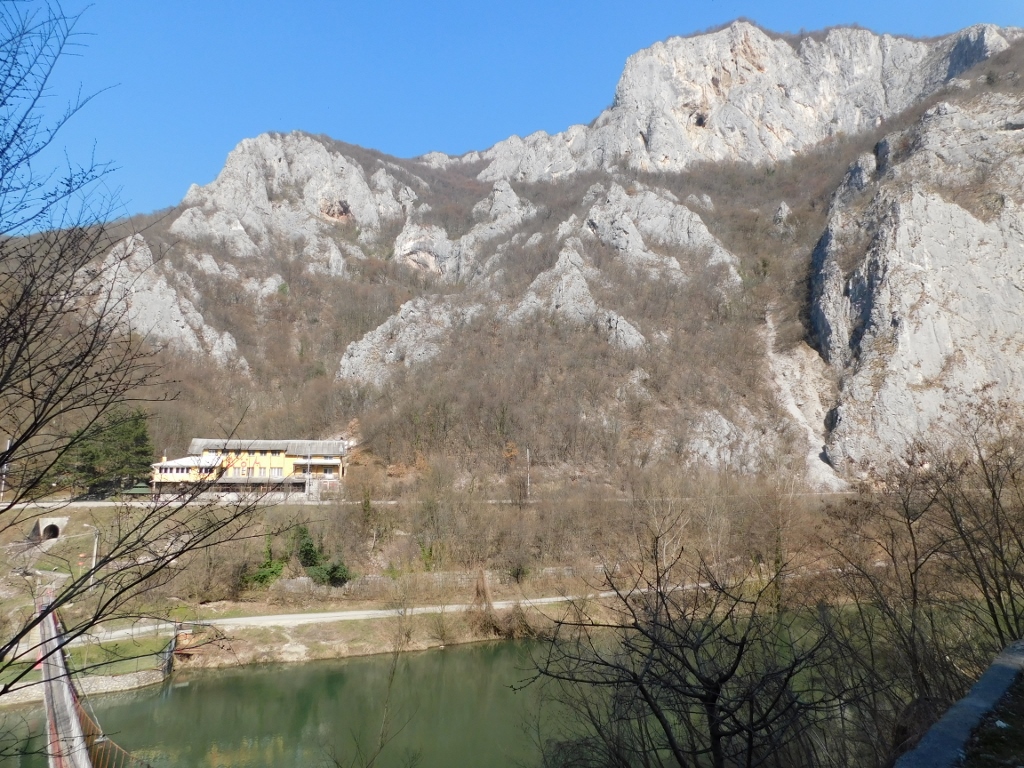 View at Kablar
View at Kablar
A few dozen metres farther from the place one gets to after reaching the dry land by the bridge and climbing some concrete steps, there is a larger paved area, as well as a sign pointing to the Monastery of the Transfiguration (Preobraženje) that is on the opposite side of the road. This is yet another one of the monasteries on mount Ovčar, but this one is very close to Čačak – Požega road, some 400 m away from the road. It is possible to drive up to the monastery, but it is also good to make a break here and leave the car in that parking lot by the road. Namely, there is a powerful water spring beside the paved area. Every time I passed by this place I enjoyed the fresh water that comes up to the surface here. Note the water which jets into a large receptacle.
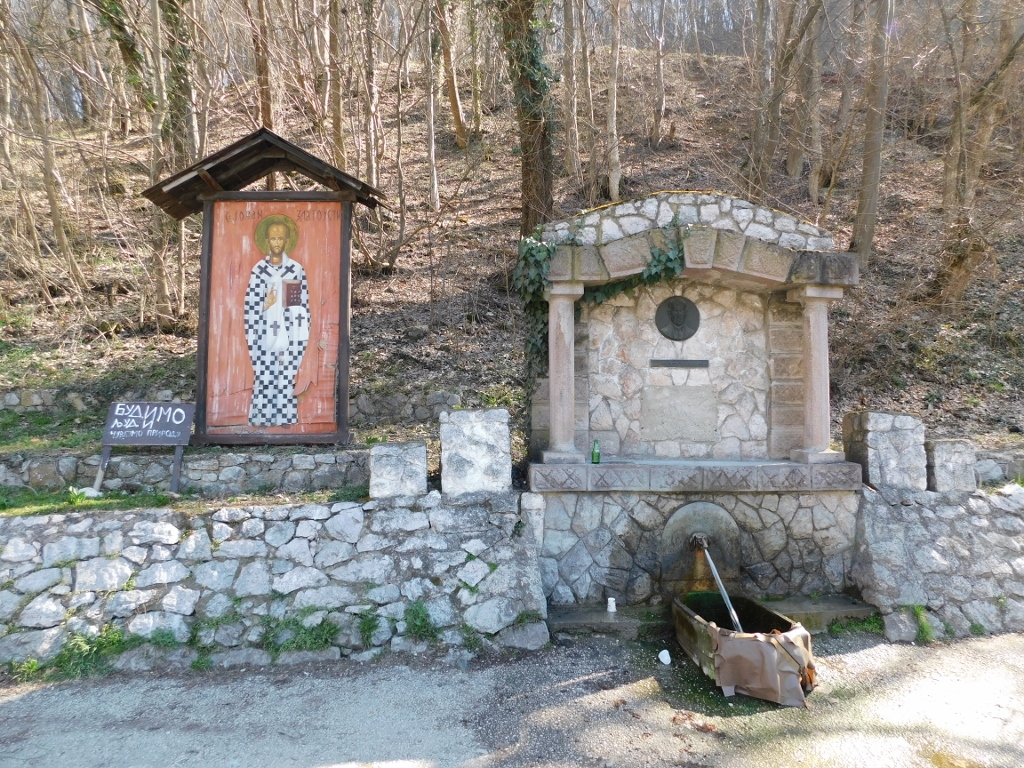 Water spring in the direct proximity to the road and the Monastery of the Transfiguration
Water spring in the direct proximity to the road and the Monastery of the Transfiguration
I followed the side road up towards the Monastery of the Transfiguration and along the way I came across a couple of monks who were doing something by the road. When I reached the monastery, it seemed rather deserted.
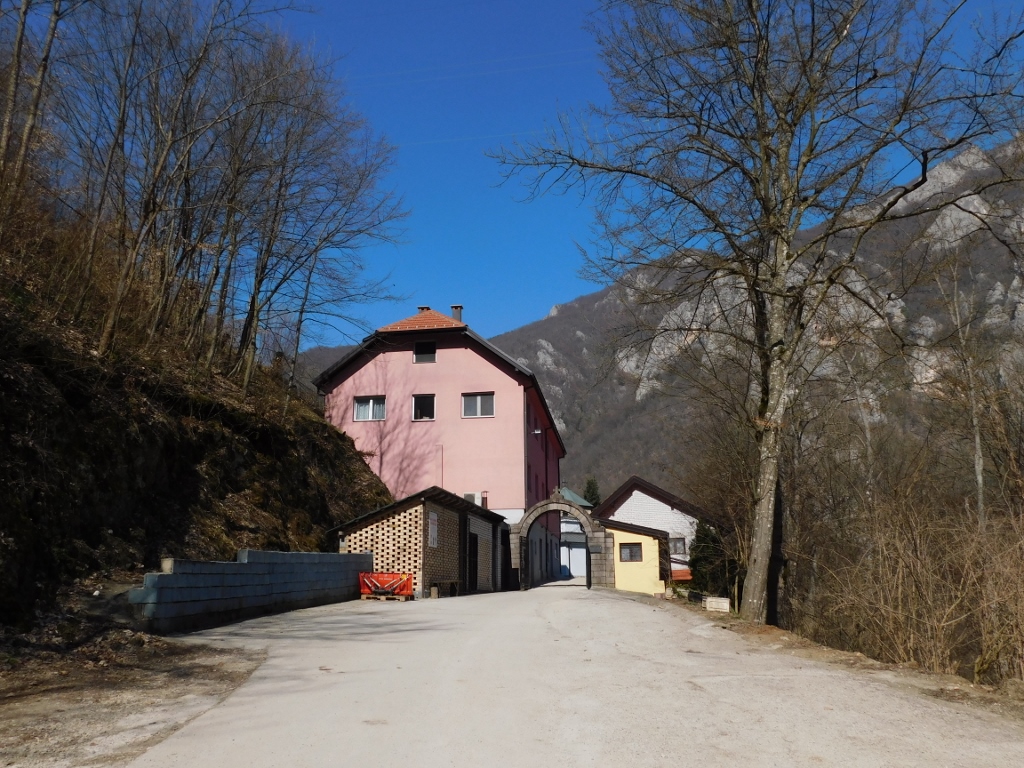 Entrance into the Monastery of the Transfiguration
Entrance into the Monastery of the Transfiguration
First I put on that skirt of mine over my pants and then I entered the monastery yard. There were also signs showing photography was not allowed, so I did not take any photos here.
The Monastery of the Transfiguration is mentioned in written sources for the first time in 1525. During this century and the next one, there was an intensive transcribing activity here, but later the monastery got deserted and it stood like that until 1811 when it was restored, only to be deserted once again. It is interesting that originally the Monastery of the Transfiguration was on the other side of the Zapadna Morava, but it was torn down in 1910 in order to build Čačak-Višegrad railroad (via Užice). There is no data left about the appearance of the original church, but there are allegedly numerous records of the consequences suffered by those who approved and ordered the destruction of this monastery.
In 1938, Bishop Nikolaj Velimirović, later canonised as Saint Nikolaj of Ohrid and Žiča, started an initiative to build the monastery again and that new monastery was consecrated precisely by Bishop Nikolaj in 1940 who left the monastic community with a behest that the brotherhood should not have either livestock or property, but rather that they should live only on prayer which shall be all the source of their livelihood. So, to this very day, the monks here do not have any material property, while the monastery is still respected as a great holy place.
I entered the church and looked around a little bit, and then I wanted to light candles. I bought some, leaving the money in the place marked for the purpose, and then I saw that there was a note asking visitors to leave the unlit candles in two places, like deep boxes (one for the living and the other for the dead), and then the monks would light them later during their service and prayer. I did as I was asked.
When I left the church I came across a monk and then we talked a little bit. Somehow we also mentioned candles, so I told him I had left them in the boxes and he said I didn’t need to. Apparently, they have the note for the cases when there are large crowds at the church, while on this day I was completely alone. He also told me that they have problems with candles made of natural beeswax, since the imports of the beeswax had drastically declined, having been imported from Ukraine. This is why they are asking the visitors now to light only one candle for the living and one candle for the dead in order to save on the consumption of beeswax candles.
In the end I told him I had seen the sign saying that photography was not allowed, but I still wanted to ask him for a permission to take a photo of the church from the outside. He granted it, so here is what the church looks like.
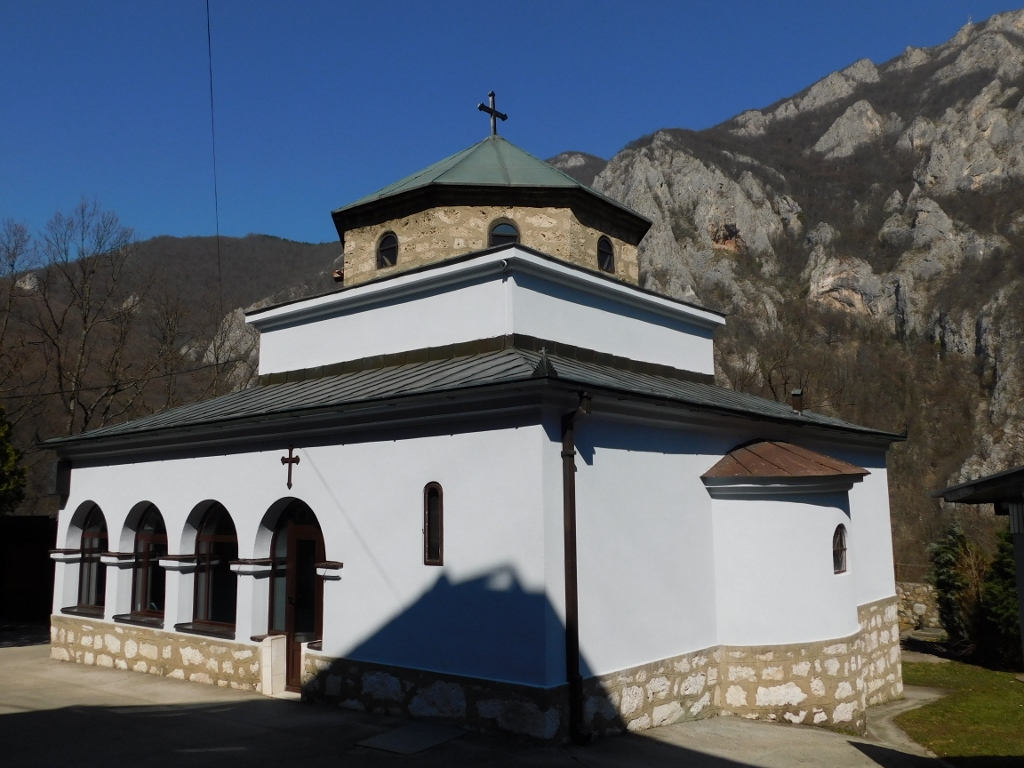 Church of the Monastery of the Transfiguration
Church of the Monastery of the Transfiguration
By the way, the Hermitage of St. Sava (the Church of Savinje, Savina Voda) that is located on mount Kablar is under the administration of the Monastery of the Transfiguration. At a certain angle, both of these holy places could be seen at the same time.
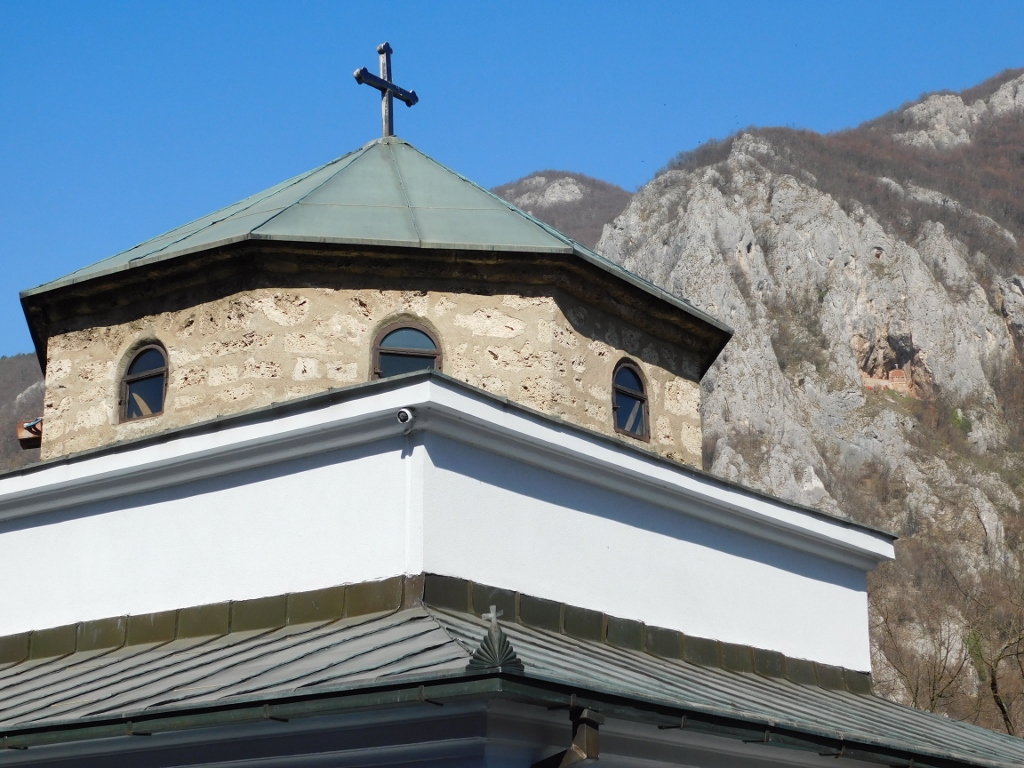 Church of the Monastery of the Transfiguration, with the Hermitage of Saint Sava in the distance
Church of the Monastery of the Transfiguration, with the Hermitage of Saint Sava in the distance
In addition to the Hermitage of St. Sava, the church of Kađenica that is situated in one of the caves of the Ovčar-Kablar Gorge is also under the administration of this monastery and this is the only church in the Minor/Serbian Mount Athos area that I did not visit on this occasion.
I thanked the monk and left the monastery, took off that skirt I had on, drank some water and was ready to start climbing a dirt road that later turned into a walking trail that runs up mount Ovčar. In comparison to the trail I followed the previous day when I went towards the top of Kablar, this one seemed very easy and completely harmless, but still the road is very steep from time to time, plus, it just goes up all the time, with no flat sections. That means that I often found this rather strenuous.
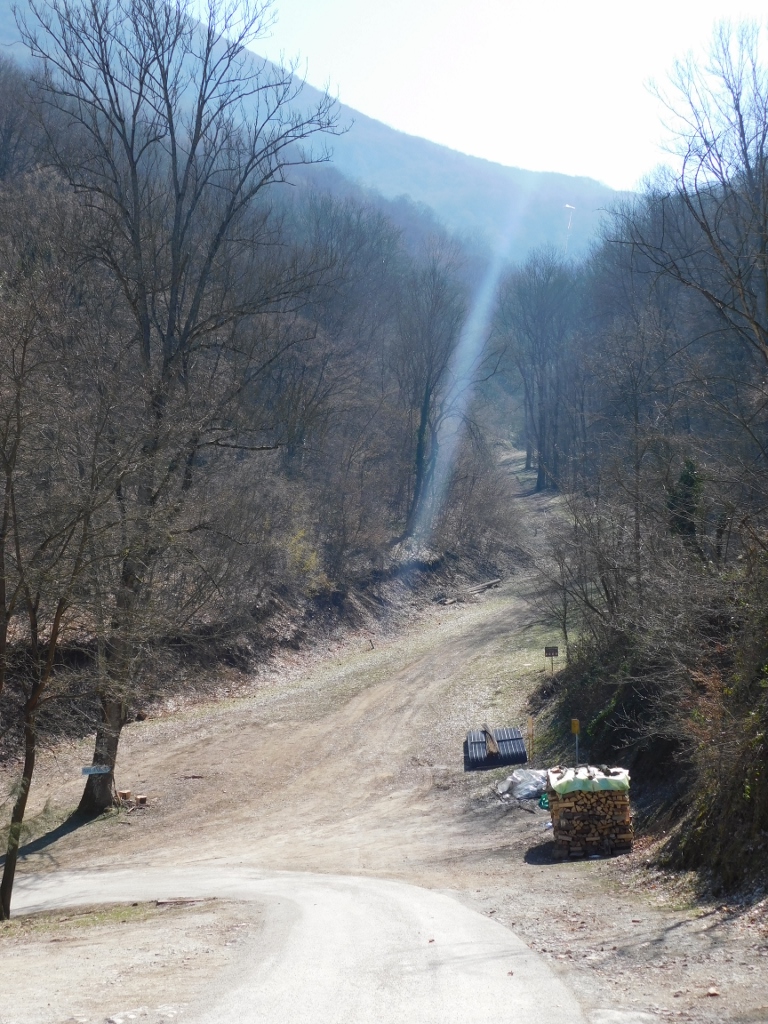 Beginning of the dirt road near the Monastery of the Transfiguration
Beginning of the dirt road near the Monastery of the Transfiguration
After a while and numerous breaks, I saw a man, among the trees, foraging for something on the slope beside the dirt road. I greeted him with: “Good morning!,” he greeted me back and also added that I could ask him anything I wanted. I found this cute, so I asked him if he was picking mushrooms, but he said it was not mushrooms, but rather ramsons that he was foraging for.
Then the two of us started chatting, first about ramsons and then about all sorts of things. At some point that man said he had to sit down, which he did right there on the slope where he was picking ramsons, and I also sat down on a fallen tree by the road. And so, the two of us kept chatting nicely at the distance of a dozen metres. Still, at some point I had to continue, while he, still in good humour, said that the next time he came to the forest he would make sure to bring some coffee in order to be able to offer it to “such a lady, in case he comes across one.” I said that I would have really appreciated a coffee and that it was a very good idea, but that now I had to move. We parted cordially, with me continuing uphill, while he continued to pick the ramsons.
The ramsons or wild garlic or bear’s garlic (Allium ursinum) has become in the recent years more popular than ever before and now it can be bought in the Serbian urban green markets in the early spring. This is a wild, exceptionally healthy plant that has an intense aroma of garlic. I remember when I used to hike around Montenegro that once I was walking down mount Bjelasica towards Biogradsko lake and that the whole forest smelled of garlic. Here, however, I did not pay any attention to it previously. Now it seemed to me I could smell garlic as I walked, but I first thought it was merely an autosuggestion of a kind. However, I noticed some fresh green leaves coming out of the ground, so I picked one and smelled it. Namely, it is very important that one is absolutely sure about this, because there are plants with similar leaves that are poisonous. This one, however, smelled of garlic quite clearly and intensively, so I simply ate it. I felt the garlic aroma in my mouth for the next half an hour, although I did not come across any more ramsons. It seems that it grows only in some parts of the forest.
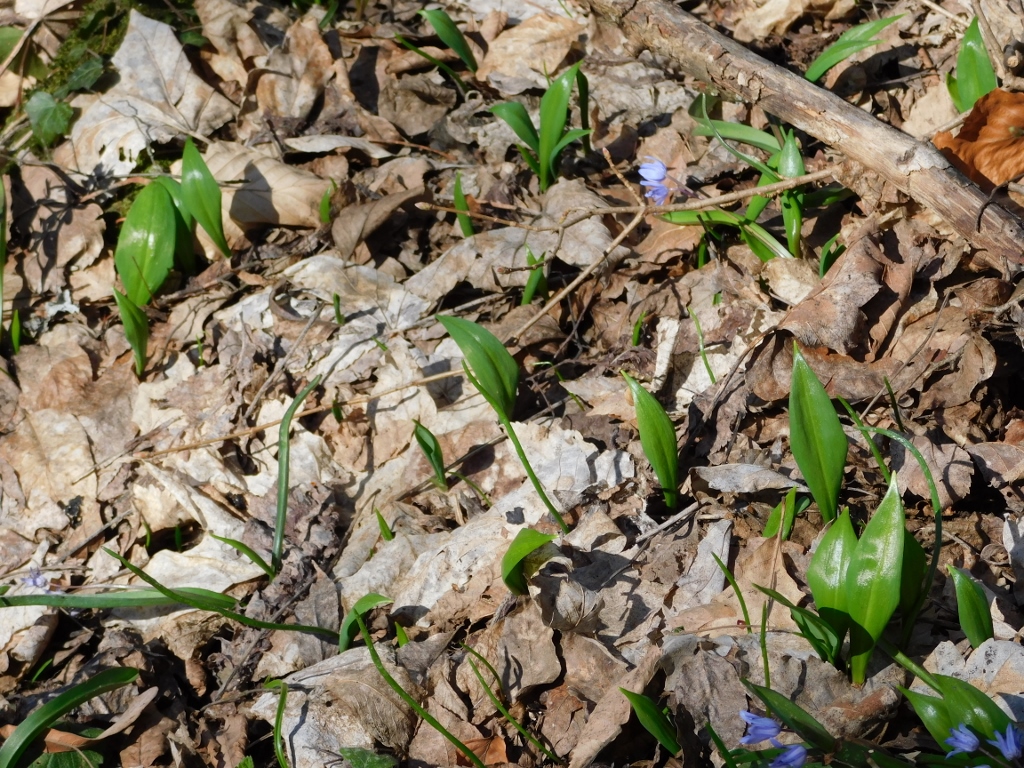 Young ramsons leaves
Young ramsons leaves
Talking about plants, this day, too, I often came across some wonderful specimens of wild flowers.
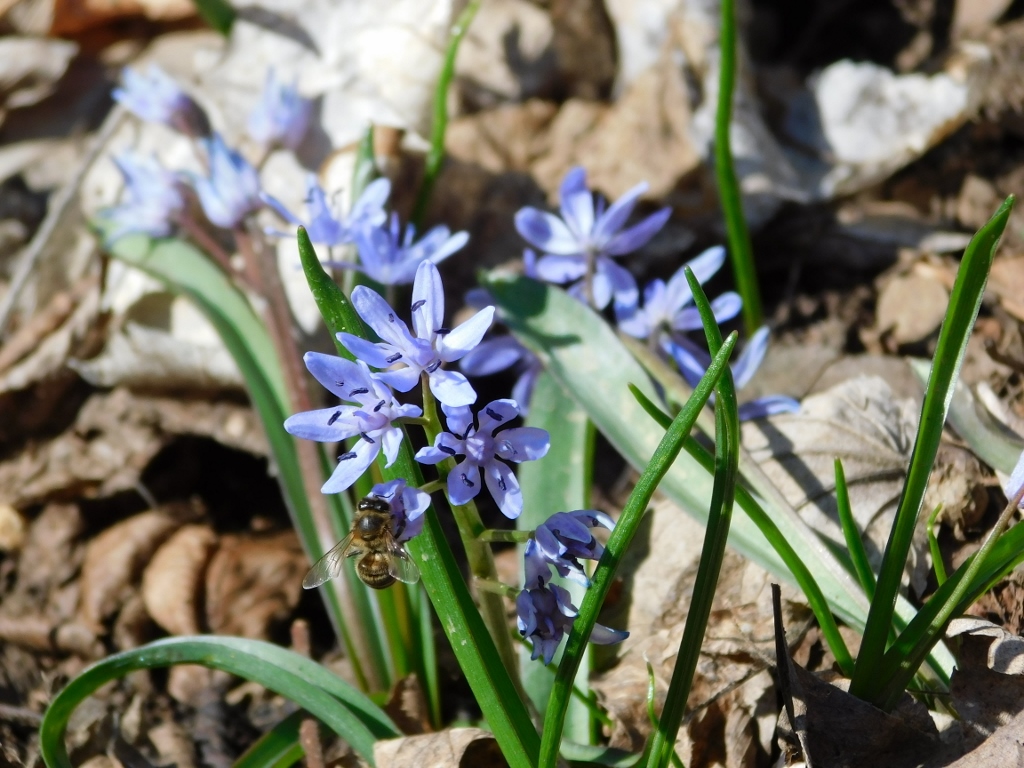 A bee and alpine squill (Scilla bifolia)
A bee and alpine squill (Scilla bifolia)
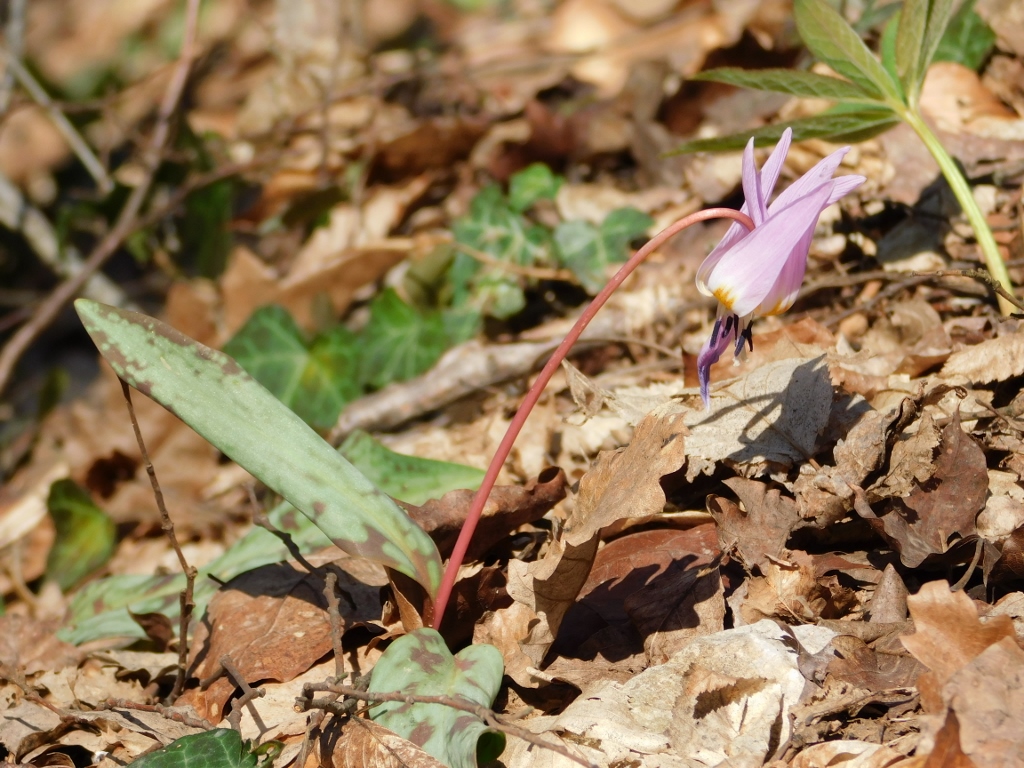 Dogtooth violet (Erythronium dens-canis)
Dogtooth violet (Erythronium dens-canis)
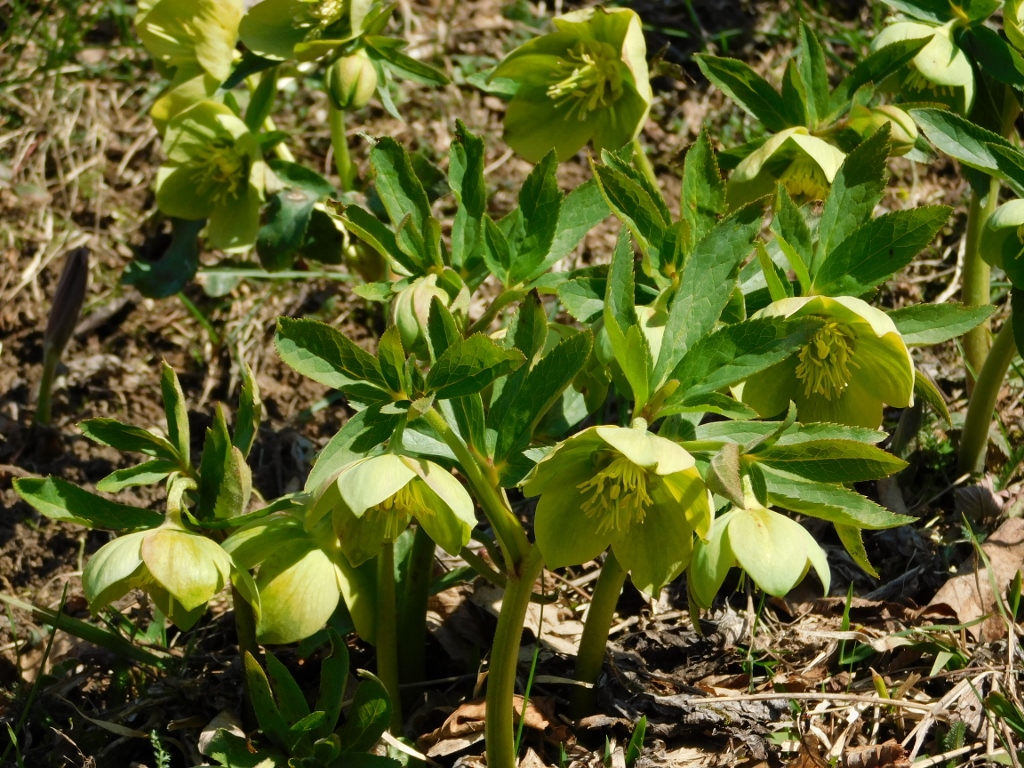 Fragrant hellebore (Helleborus odorus)
Fragrant hellebore (Helleborus odorus)
Soon the trail no longer went directly uphill, but rather started to zigzag and that certainly made the walking easier.
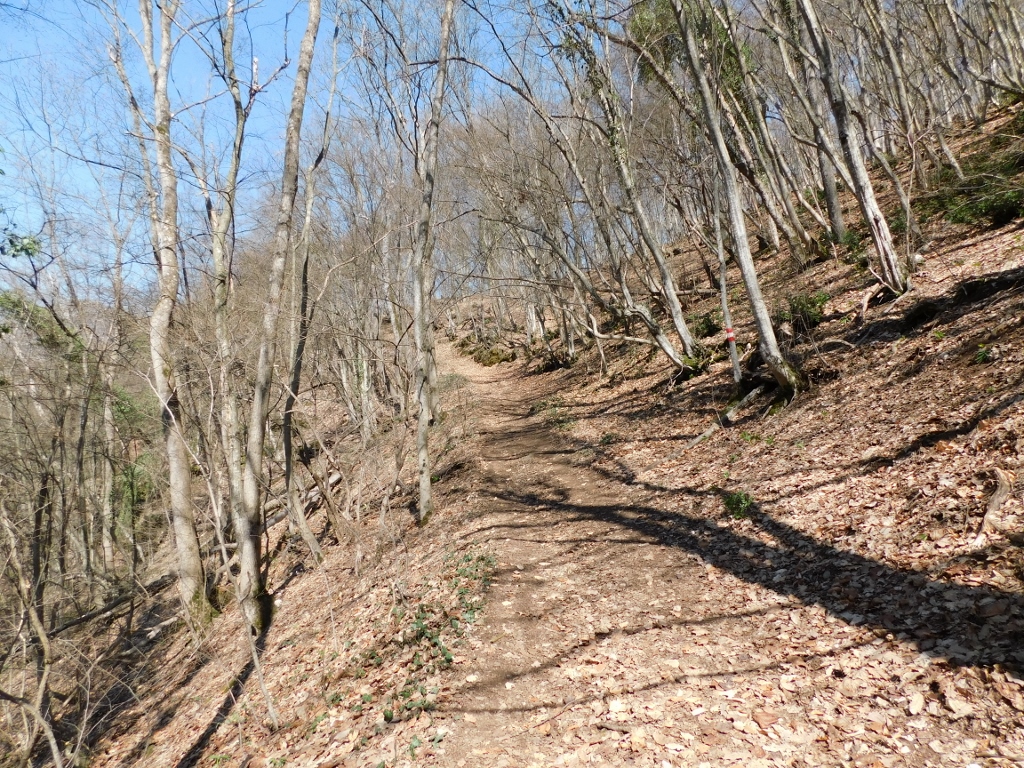 Walking trail on mount Ovčar
Walking trail on mount Ovčar
At some point I reached the next destination and that was the Monastery of the Meeting of the Lord in the Temple (Sretenje). The next photo shows on the left the trail I came on, in the middle there is a small monastery graveyard, while to the right there is the monastery itself.
 I have reached the Monastery of the Meeting of the Lord in the Temple
I have reached the Monastery of the Meeting of the Lord in the Temple
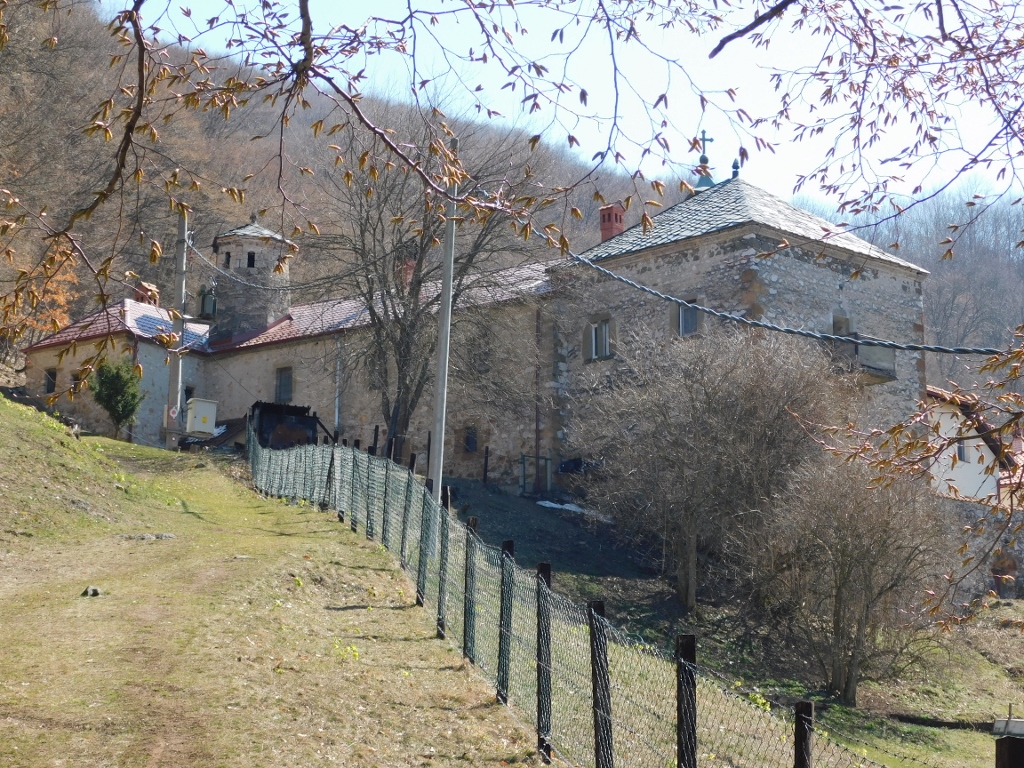 Monastery of the Meeting of the Lord in the Temple
Monastery of the Meeting of the Lord in the Temple
The monastery has been built on a slope and as the trail goes around the monastery and from above, this provides a nice opportunity to see some parts at the eye level.
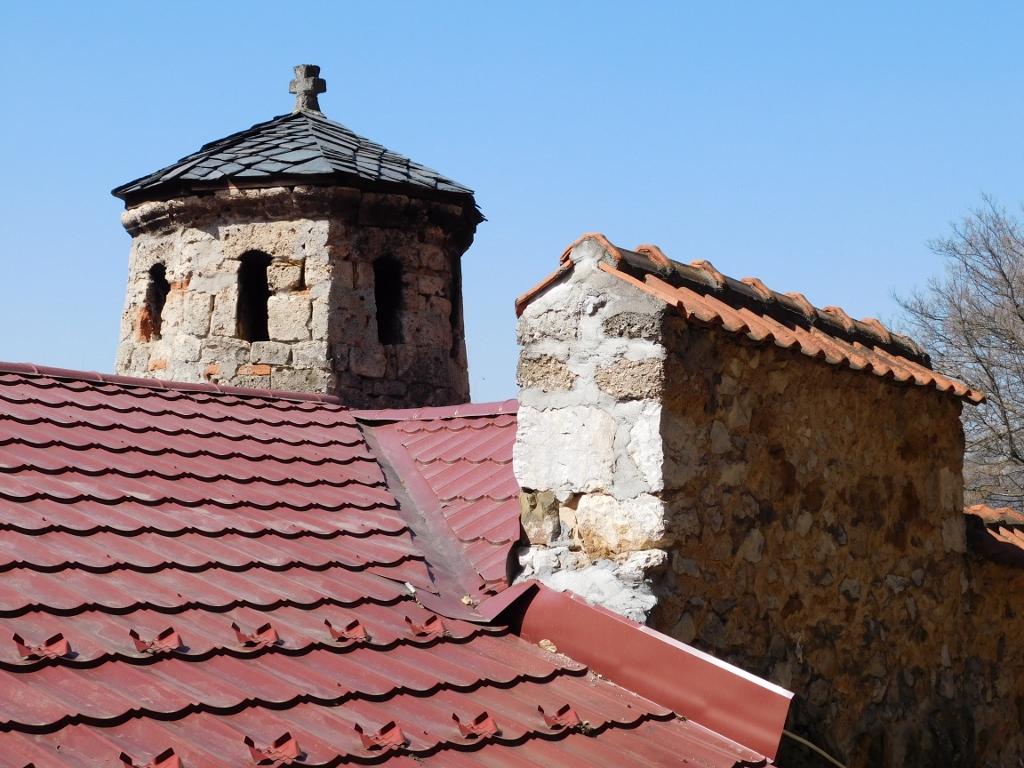 Monastery of the Meeting of the Lord in the Temple, details
Monastery of the Meeting of the Lord in the Temple, details
And then the visitor goes down to the asphalt road and the gate leading into the monastery. In other words, it is possible to get here by car, not directly from Ovčar Banja, but from the other side of mount Ovčar.
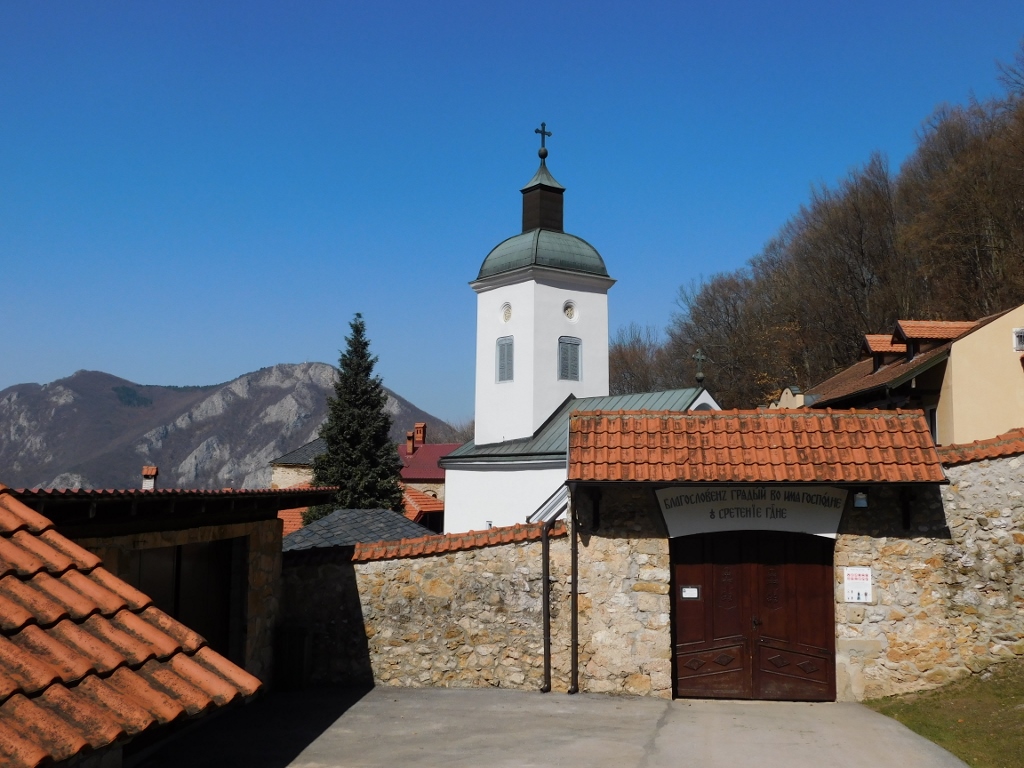 Monastery of the Meeting of the Lord in the Temple
Monastery of the Meeting of the Lord in the Temple
The Monastery of the Meeting of the Lord in the Temple is a cultural property of great importance. It is presumed that it was founded in the 16th century at the latest, because already in 1623 it was mentioned for the first time in writing by mentioning its destruction. It was restored in 1818. The church has a single nave with a five-sided altar apse and shallow choirs. There is a belfry above the narthex. The frescoes from the naos and the altar are from 1844, while a year later the monastery complex was surrounded by a wall. The metochion in village Pakovraće that I have mentioned before, but did not visit during this trip, belongs to this monastery.
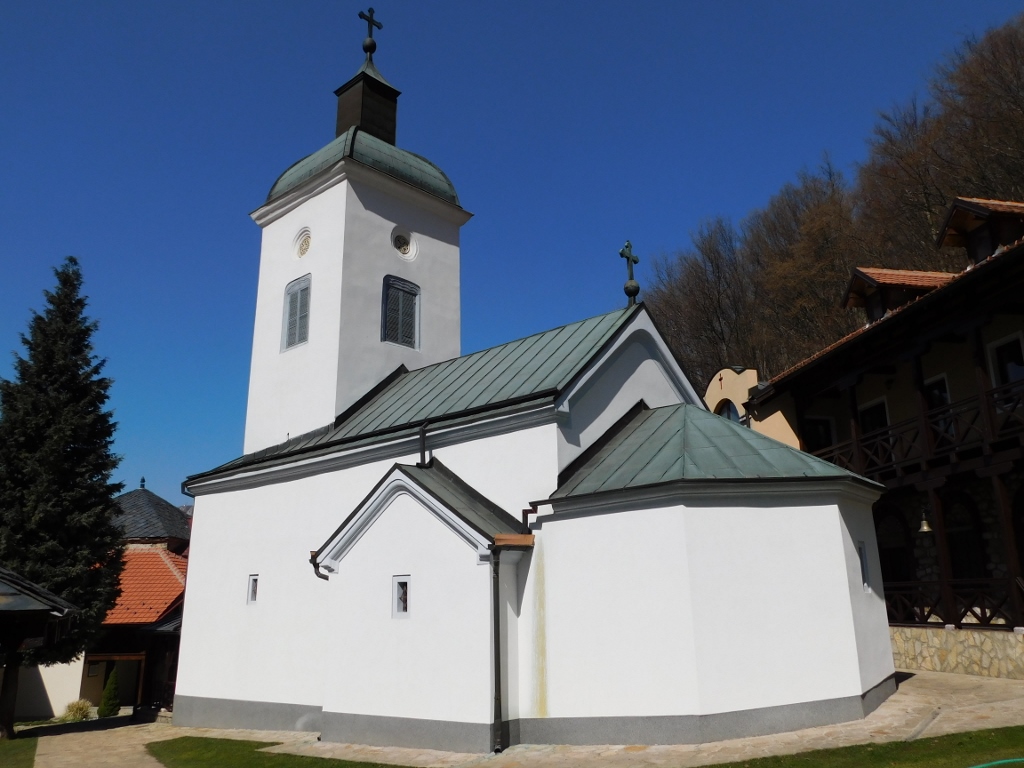 Monastery of the Meeting of the Lord in the Temple
Monastery of the Meeting of the Lord in the Temple
I was greeted here by a nun who took me into the church. I knew that photography was not permitted, at least not officially, so I did not even ask her to take photos inside the church.
But, in my documentation I also have a photo of the monastery yard taken a few years ago in September. At that time, the whole yard was full of flowers, while the slopes of mount Ovčar were completely green.
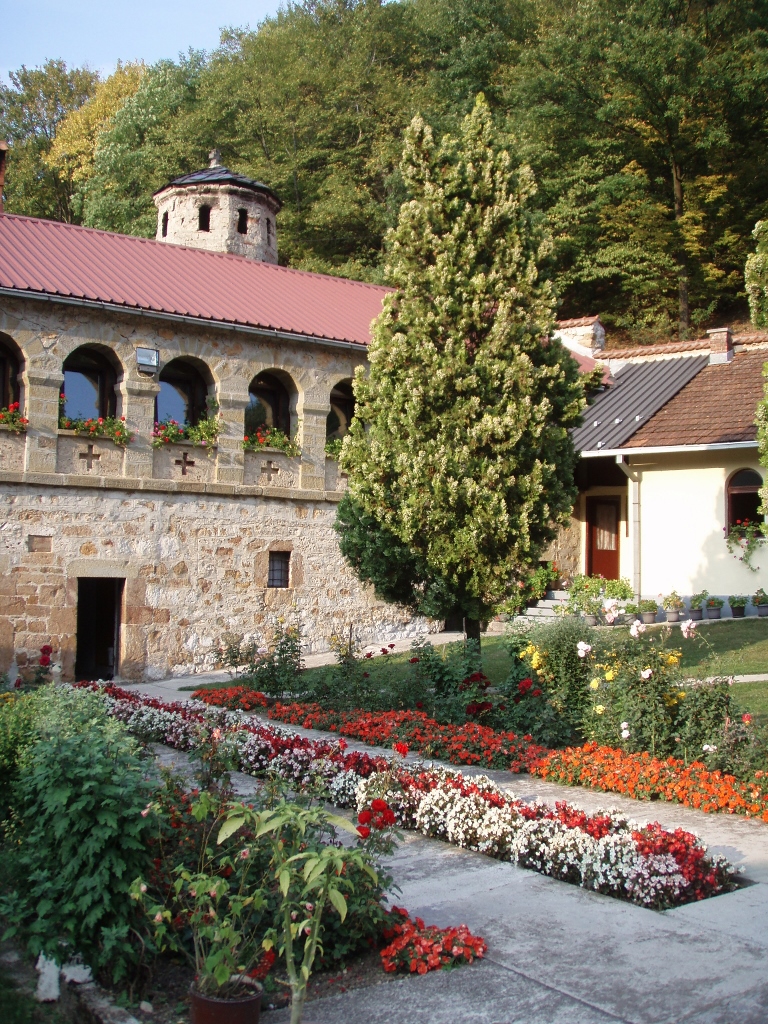 Monastery of the Meeting of the Lord in the Temple
Monastery of the Meeting of the Lord in the Temple
After our short talk inside the church, the nun asked me if I would like some coffee or tea. I thanked her, saying I would prefer coffee. I sat at a long table located in a porch and my treat was soon there. I was offered Turkish delight, coffee and water, as well as sour cherry pie.
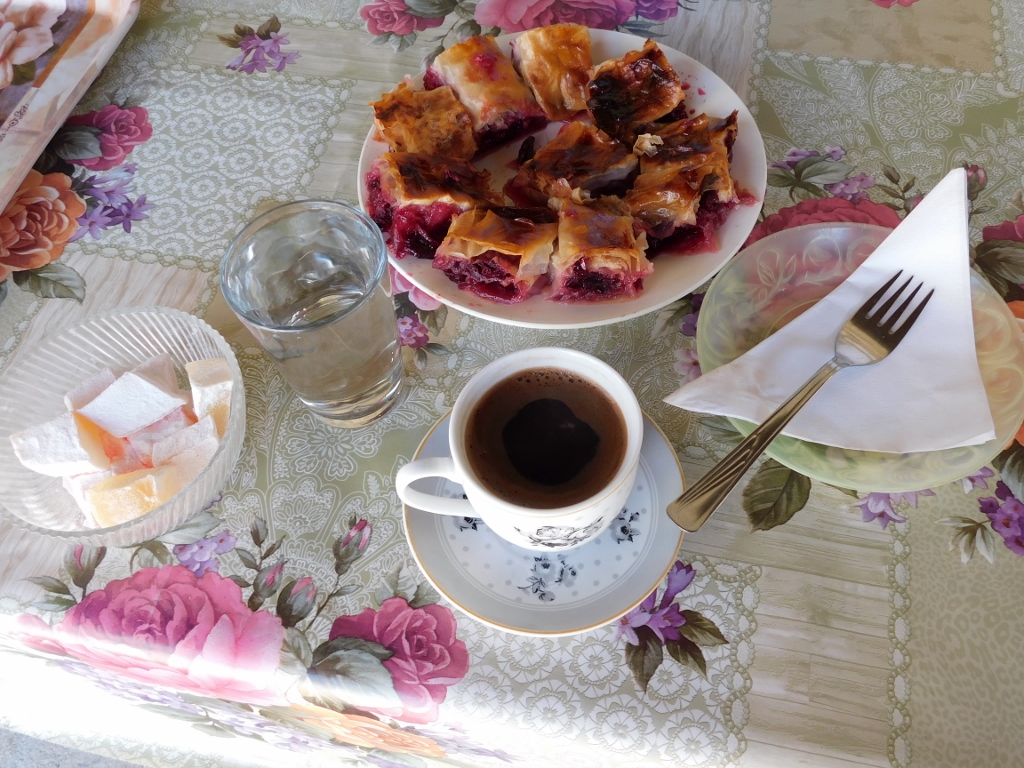 Monastery of the Meeting of the Lord in the Temple, treat for guests
Monastery of the Meeting of the Lord in the Temple, treat for guests
While I was sitting at the table, I saw a shelf in a corner full of different products made for the monastery, which the monastery then sells to visitors. There were tinctures made of wild plants, propolis drops and different ointments, as well as traditional brandy made of different fruits and wine. Since I knew I would be walking only downhill from here on, making it easier for me to carry any load, I bought a bottle of rakija (traditional brandy), as well as several other items.
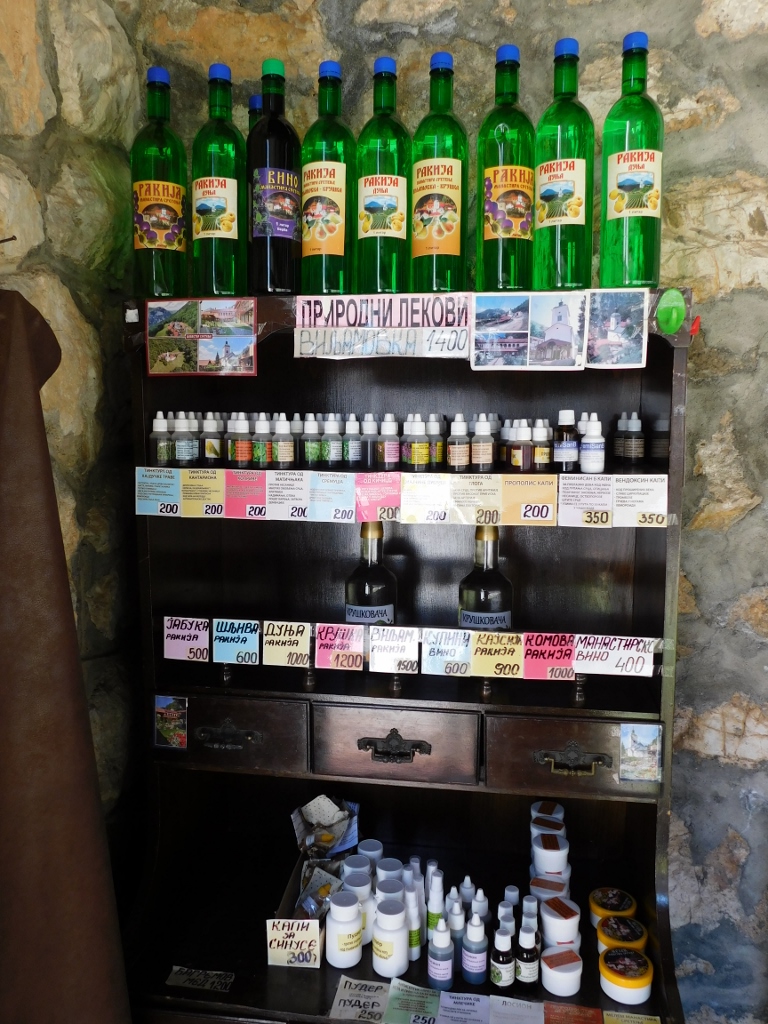 Monastery of the Meeting of the Lord in the Temple, products for sale at the monastery
Monastery of the Meeting of the Lord in the Temple, products for sale at the monastery
Soon after came two women who arrived there by car and one of them bought several jars of an ointment. She said only that preparation was suitable for her daughter’s complexion.
I thanked the nun and then I moved on from the monastery. Although originally I thought I may go up to the very top of mount Ovčar, I decided not to do it this time. The reason was that I walked a lot the previous day, which was very strenuous, and although I felt good now, there was no need for me to exaggerate. After all, I’ve gone to the top that is at the elevation of 985 m a.s.l. several times in the past and here is a photograph from 2009 that allows a peek at the Zapadna Morava meanders through the greenery. The view is certainly breathtaking and whoever has not been there before, it makes it worthwhile going to the top of Ovčar.
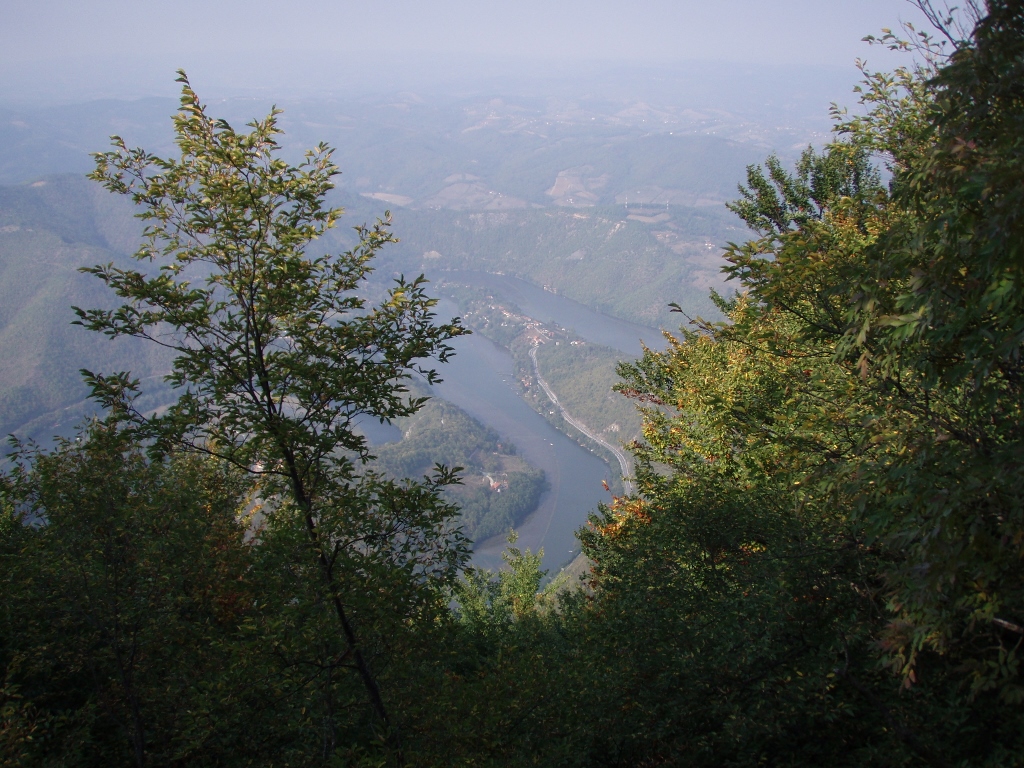 View at the Zapadna Morava meanders from the top of mount Ovčar when the trees have the foliage
View at the Zapadna Morava meanders from the top of mount Ovčar when the trees have the foliage
What I did now was to continue walking along the asphalt road that is used to reach the Monastery of the Meeting of the Lord in the Temple. Very close to the gate leading inside the monastery, there is another spring of fresh and potable water.
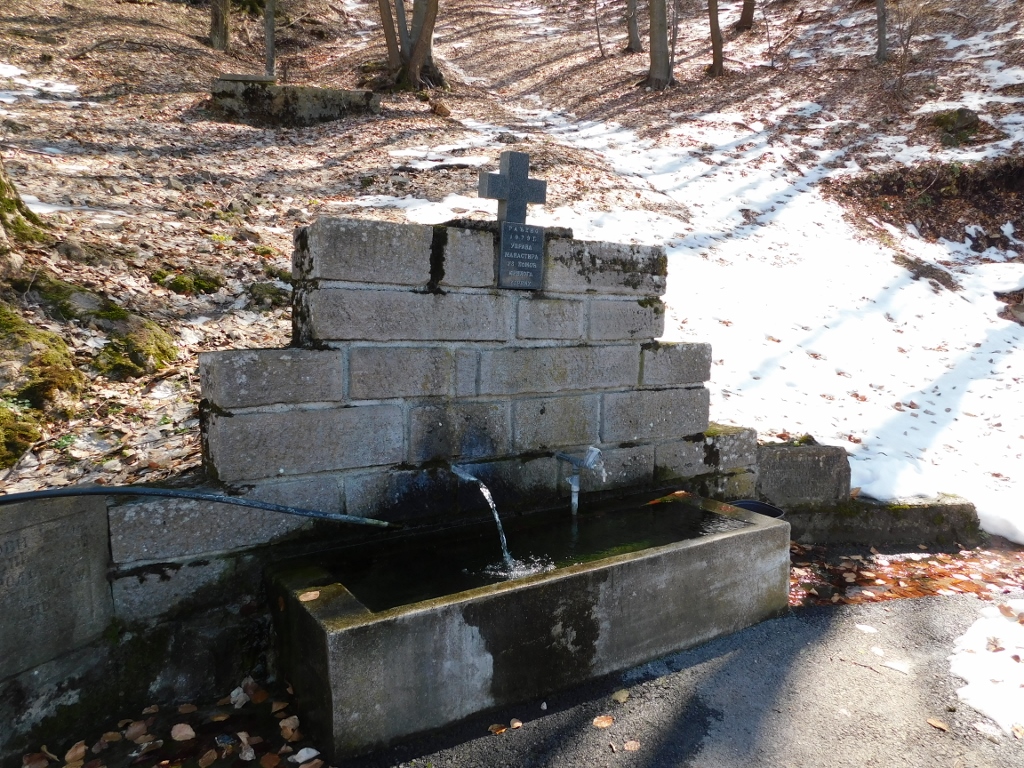 Water spring by the Monastery of the Meeting of the Lord in the Temple
Water spring by the Monastery of the Meeting of the Lord in the Temple
As it may be seen in the previous photo, there was still snow in some areas around the monastery, which I could see the day before from Kablar. Now I saw it all again, but from up close. This time I could also see mount Kablar on the other side of the gorge.
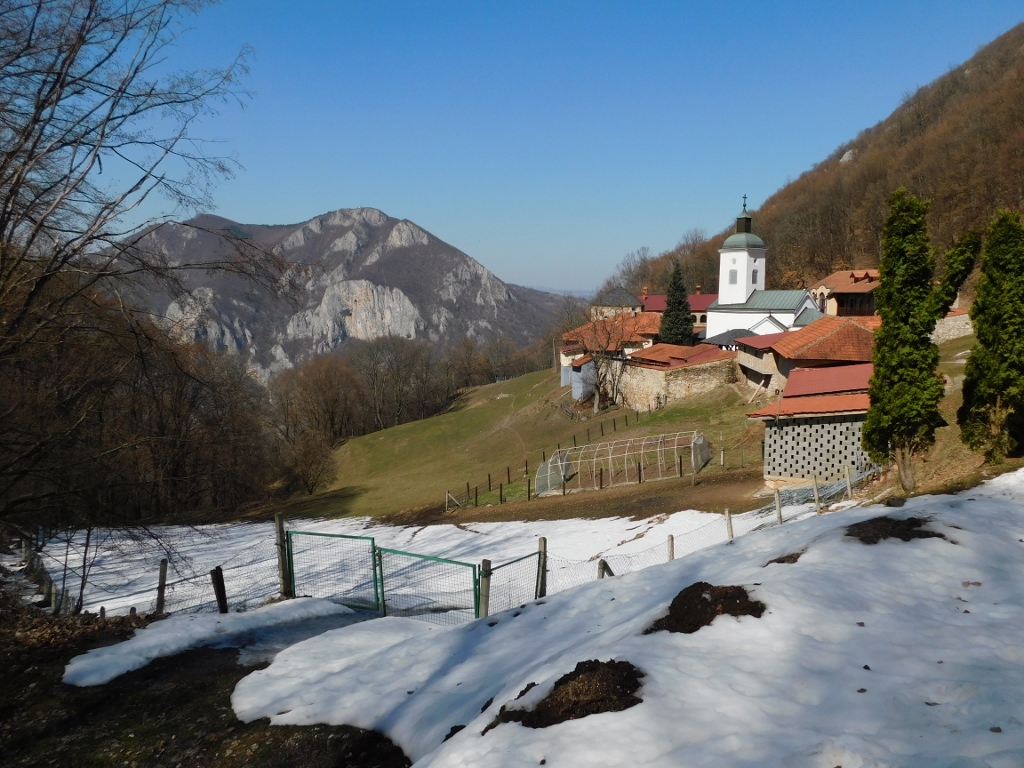 Mount Kablar and the Monastery of the Meeting of the Lord in the Temple a the slope of mount Ovčar
Mount Kablar and the Monastery of the Meeting of the Lord in the Temple a the slope of mount Ovčar
 Mount Kablar and the Monastery of the Meeting of the Lord in the Temple a the slope of mount Ovčar
Mount Kablar and the Monastery of the Meeting of the Lord in the Temple a the slope of mount Ovčar
I continued along the asphalt road until a point where a walking trail started downhill towards yet another monastery – the Monastery of the Holy Trinity (Sveta Trojica).
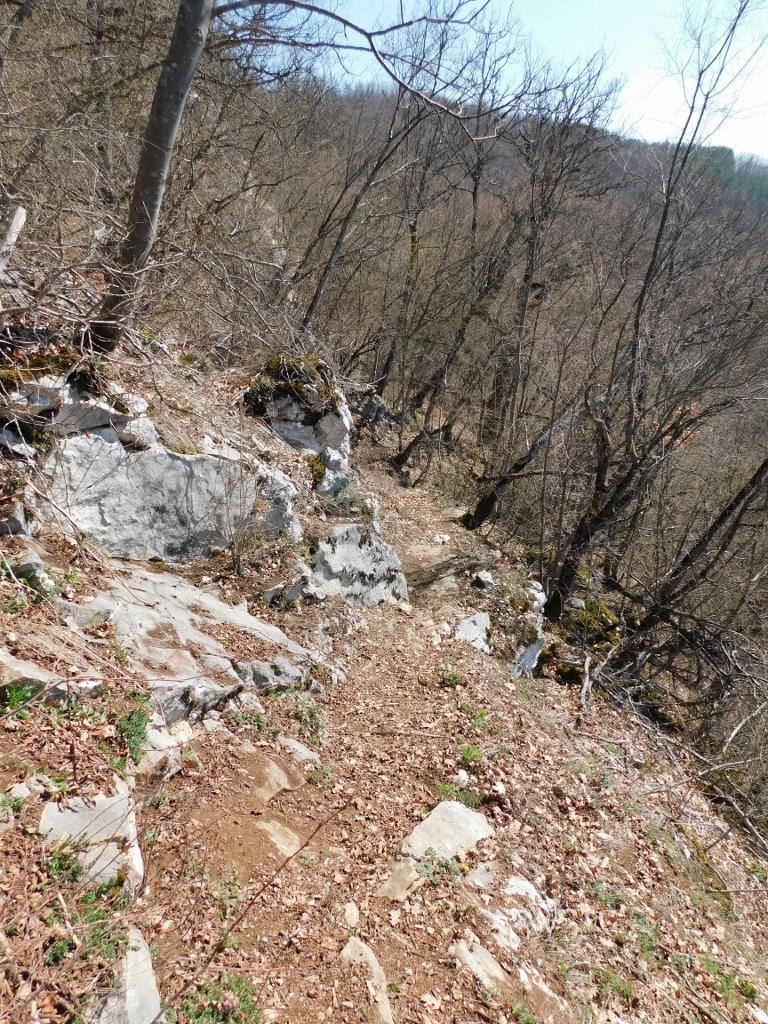 Walking trail towards the Monastery of the Holy Trinity
Walking trail towards the Monastery of the Holy Trinity
Soon I saw the monastery itself.
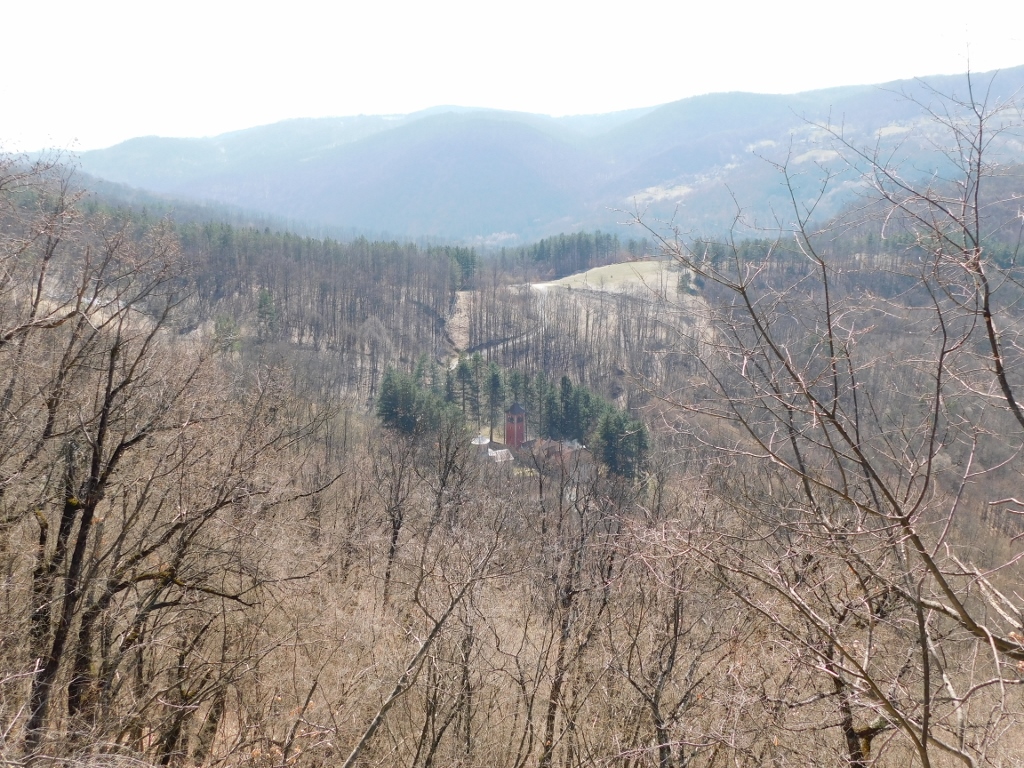 Getting closer to the Monastery of the Holy Trinity
Getting closer to the Monastery of the Holy Trinity
As it may be seen in the photo, I visited the Ovčar-Kablar Gorge around the middle of March, which means that it was early spring and the trees had still not become green. I found it interesting when I came across a similar photo in my documentation (a part of the Monastery of the Holy Trinity may be seen from above) taken in autumn when the leaves were changing their colour from green.
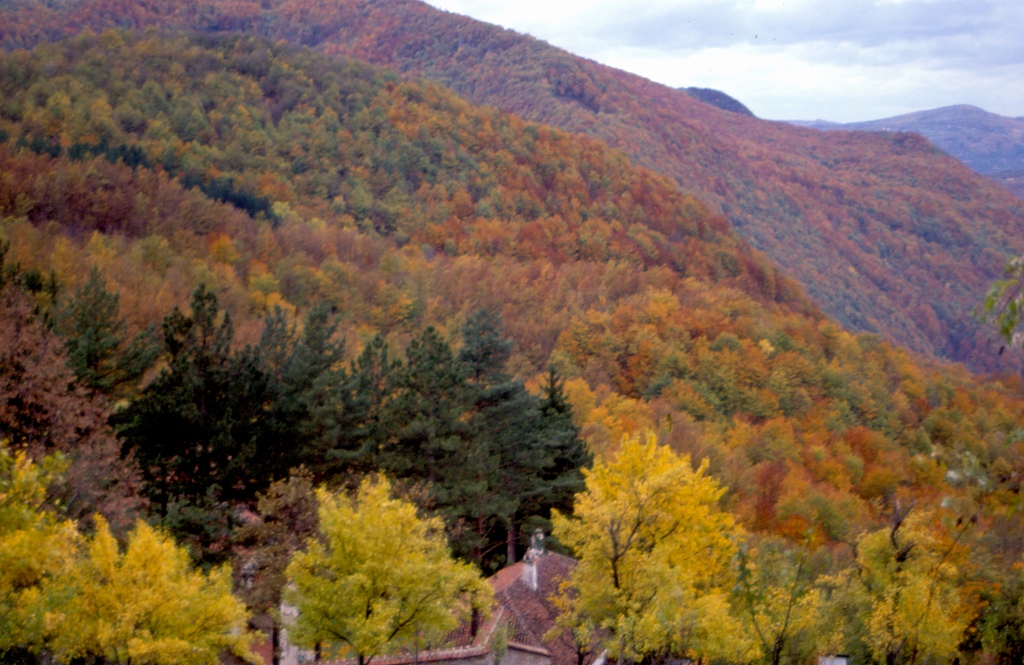 Autumn in the Ovčar-Kablar Gorge
Autumn in the Ovčar-Kablar Gorge
Soon I reached a gate through which one enters the monastery’s estate and through which passes the walking trail. That meant that the monastery was not far away.
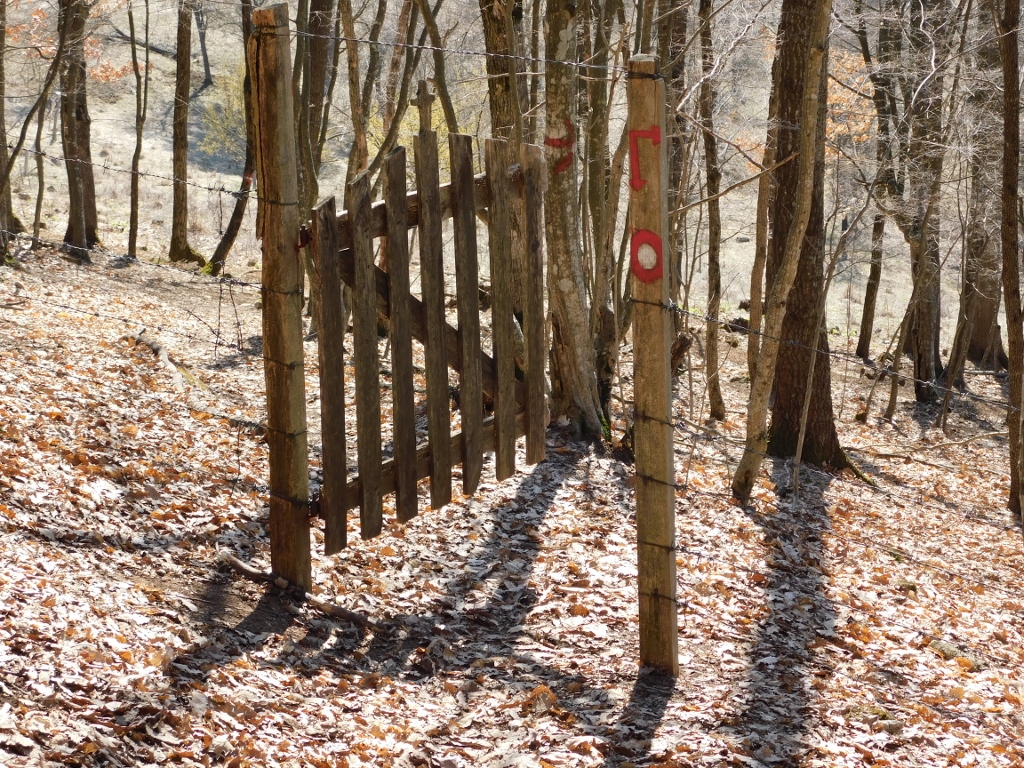 Entering the monastery’s estate
Entering the monastery’s estate
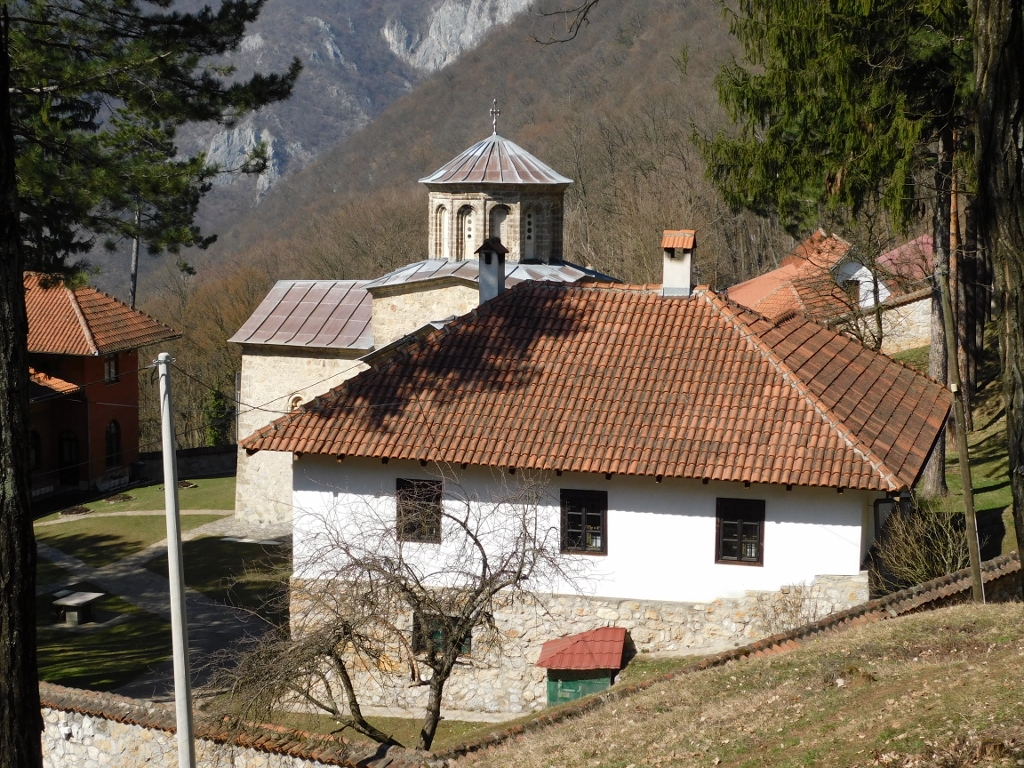 Monastery of the Holy Trinity
Monastery of the Holy Trinity
This monastery can also be reached by an asphalt road, but again not directly from Ovčar Banja, but from the other side of the mountain.
 Monastery of the Holy Trinity
Monastery of the Holy Trinity
The Monastery of the Holy Trinity is a cultural property of great importance. It was founded in the second half of the 16th century.
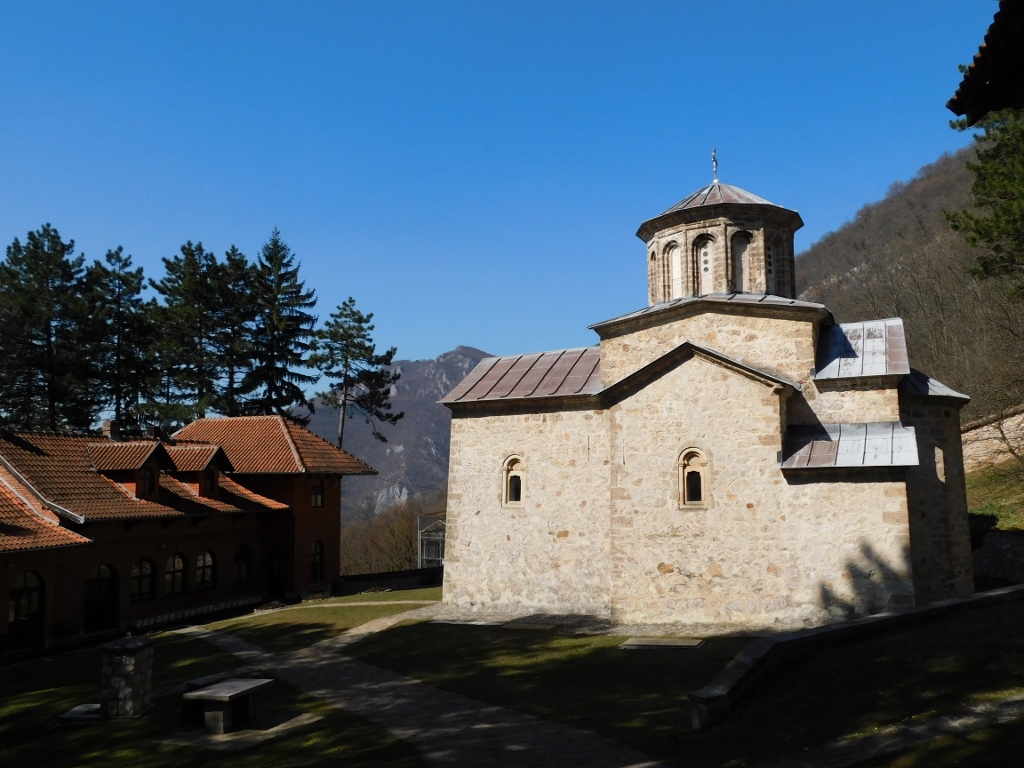 Monastery of the Holy Trinity
Monastery of the Holy Trinity
The church has the apse that is five-sided on the outside, a single-nave naos expanded by rectangular choirs and above which there is a dome with a 12-sided drum. In the lunettes above the doors there are frescoes from the 17th century, while the interior has never been fresco-painted. The high iconostasis was made in 1868.
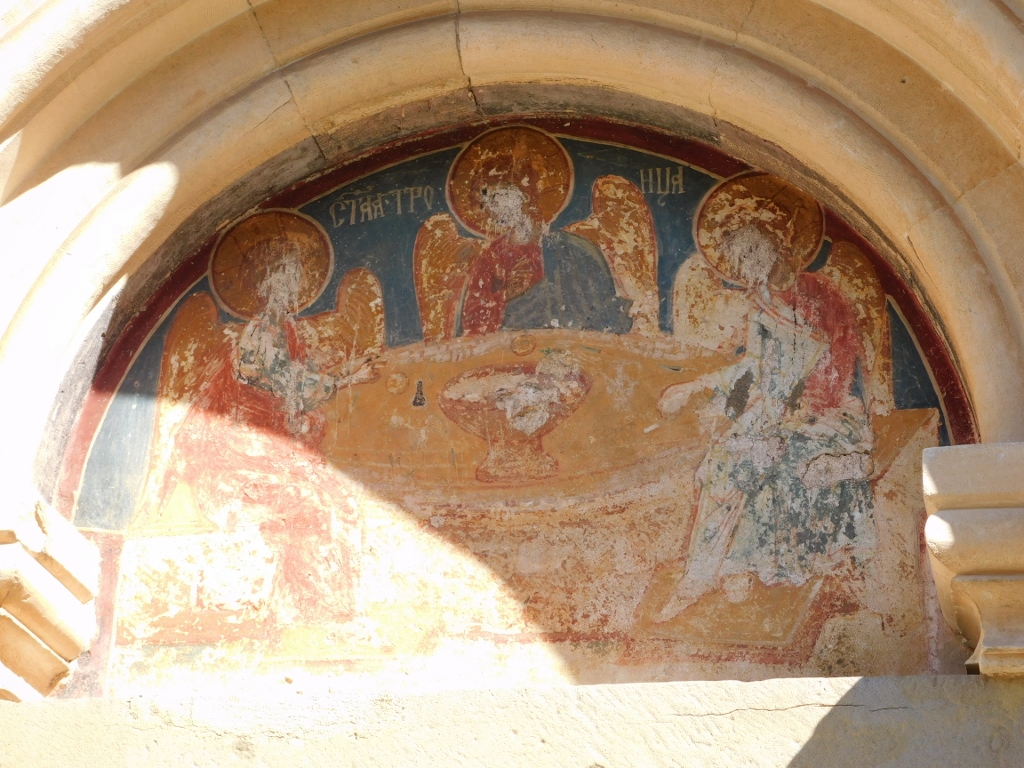 Lunette with the fresco of the Holy Trinity above the entrance into the church
Lunette with the fresco of the Holy Trinity above the entrance into the church
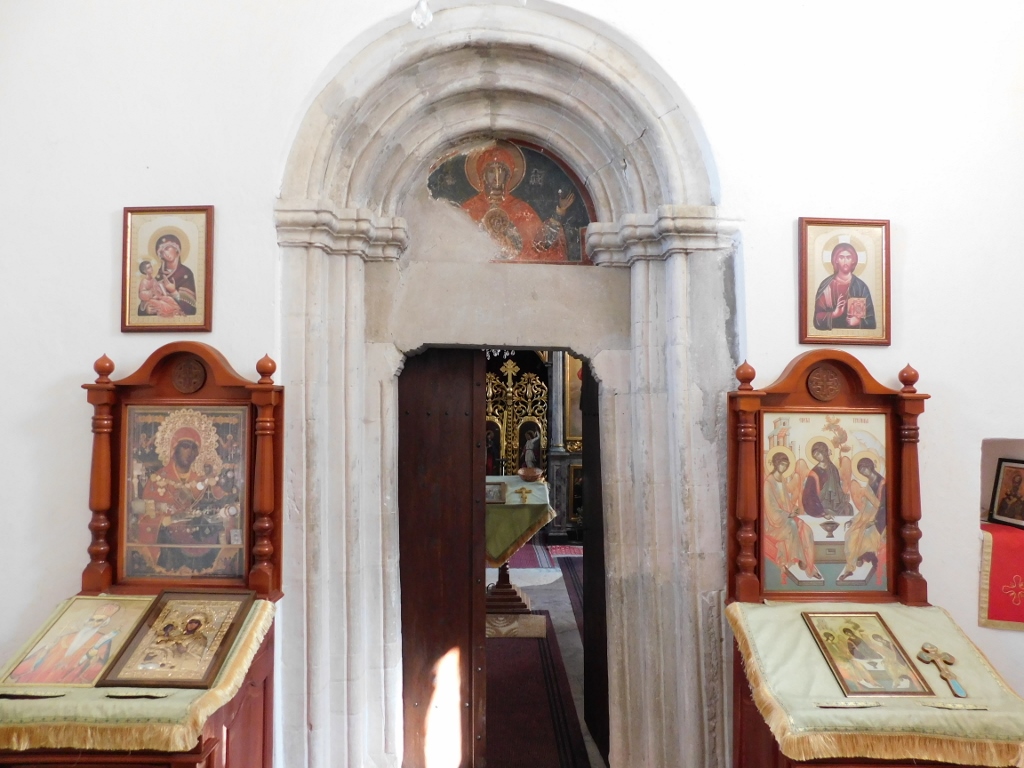 Portal between the narthex and the naos with a painted lunette
Portal between the narthex and the naos with a painted lunette
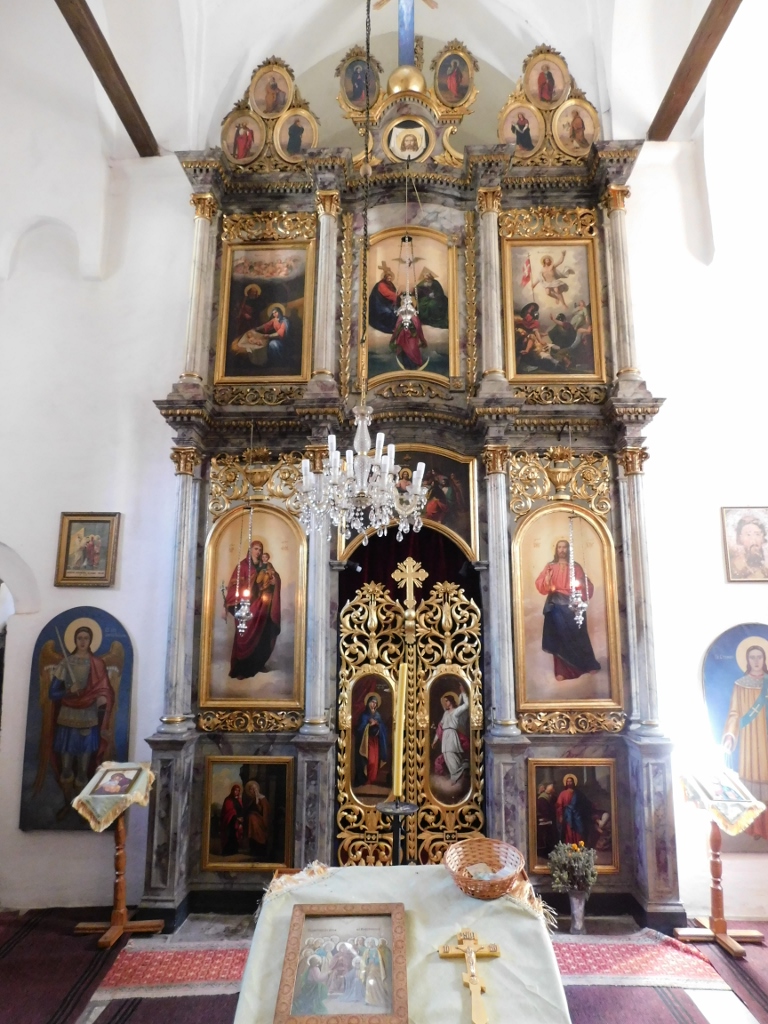 Iconostasis at the Monastery of the Holy Trinity
Iconostasis at the Monastery of the Holy Trinity
In the 19th century, the monastic community built a dormitory with a cellar made of rubble stone that constitutes an important testimony to vernacular architecture.

Here I first came across an elderly woman who, I guess, helped the monks with the serving, so she offered some water and Turkish delight, while later a monk took me to a room outside the gate where I bought some teas.
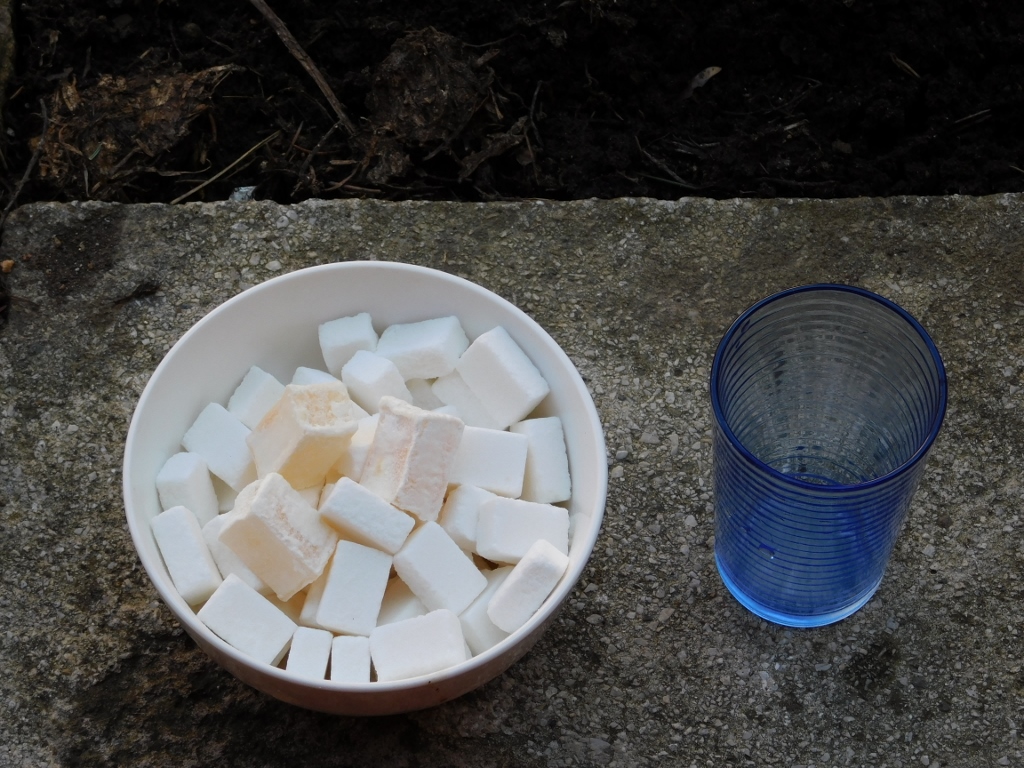 Turkish delight, sugar cubes and water (that I have already drunk) – the treat at the Monastery of the Holy Trinity
Turkish delight, sugar cubes and water (that I have already drunk) – the treat at the Monastery of the Holy Trinity
It was just as well, since that monk showed me exactly where I was to continue from there, which was not difficult to guess because the trail descends right beside the monastery walls. A few dozen metres down, again I came across a spring of fresh water that belongs to the monastery.
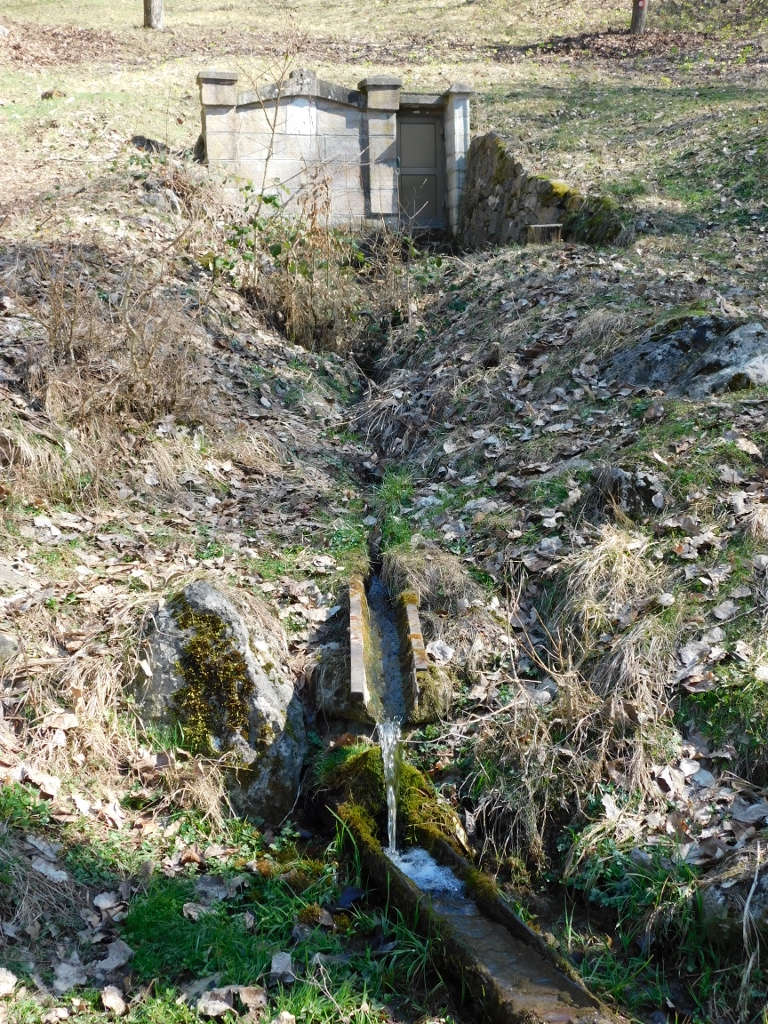 Water spring beside the Monastery of the Holy Trinity
Water spring beside the Monastery of the Holy Trinity